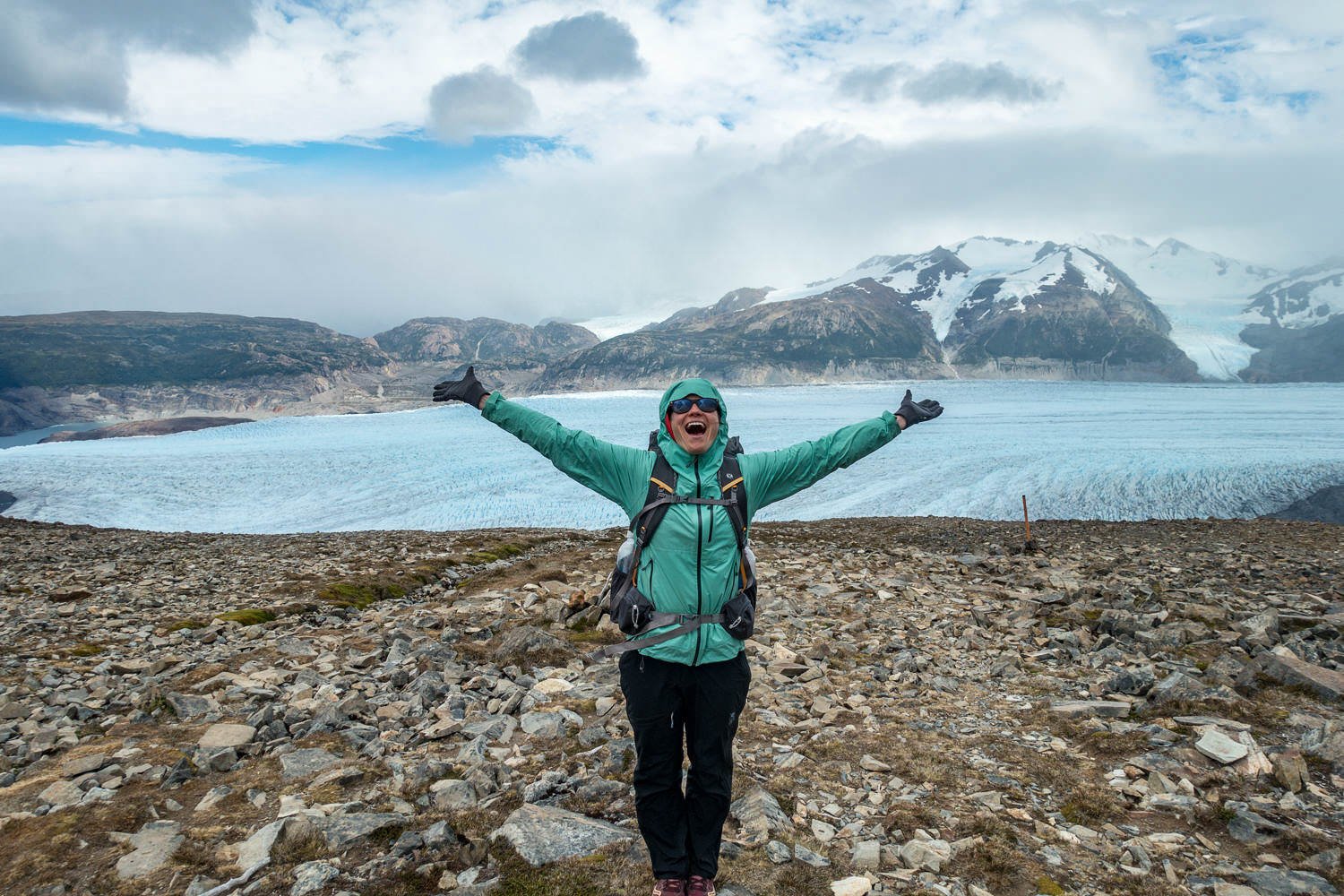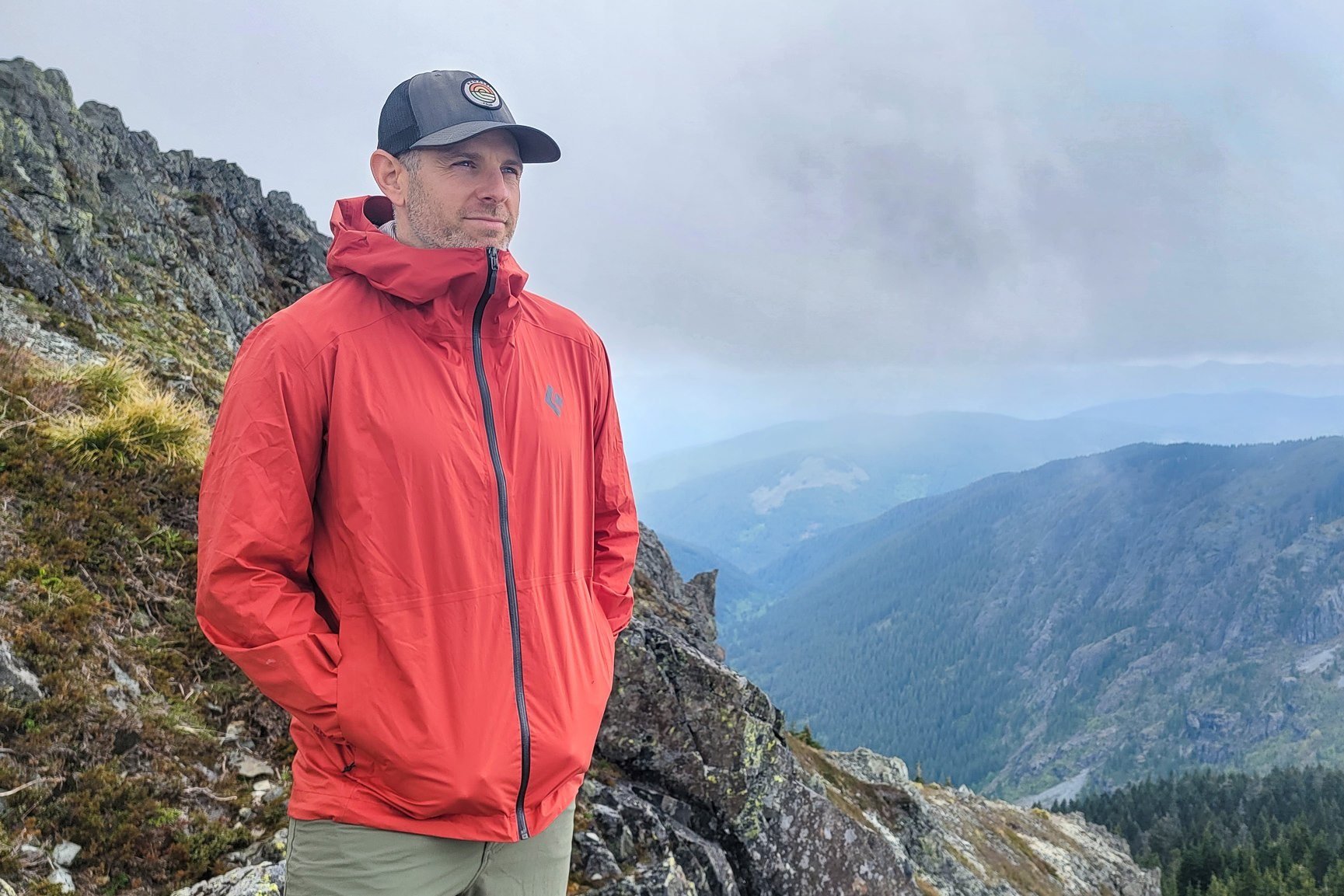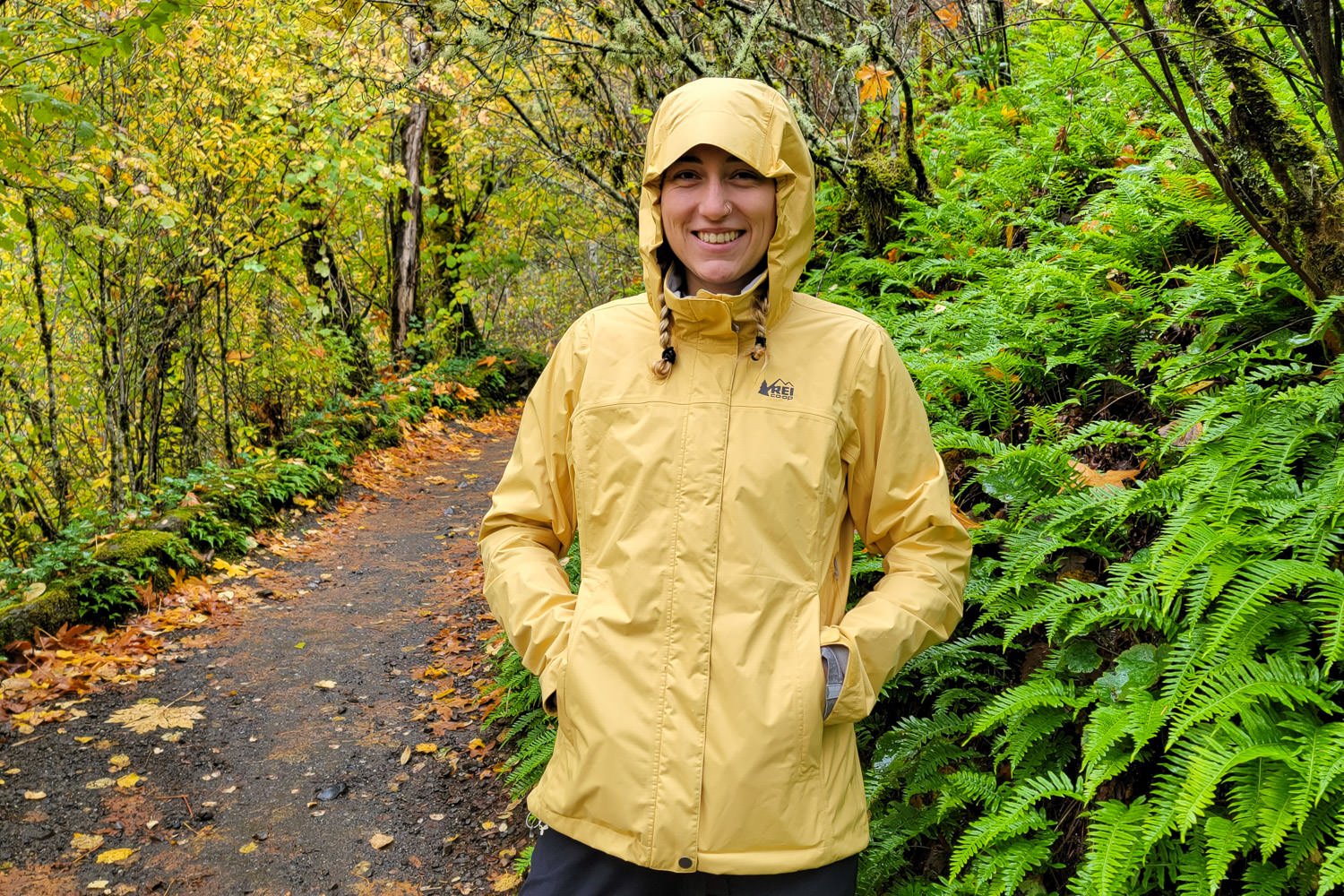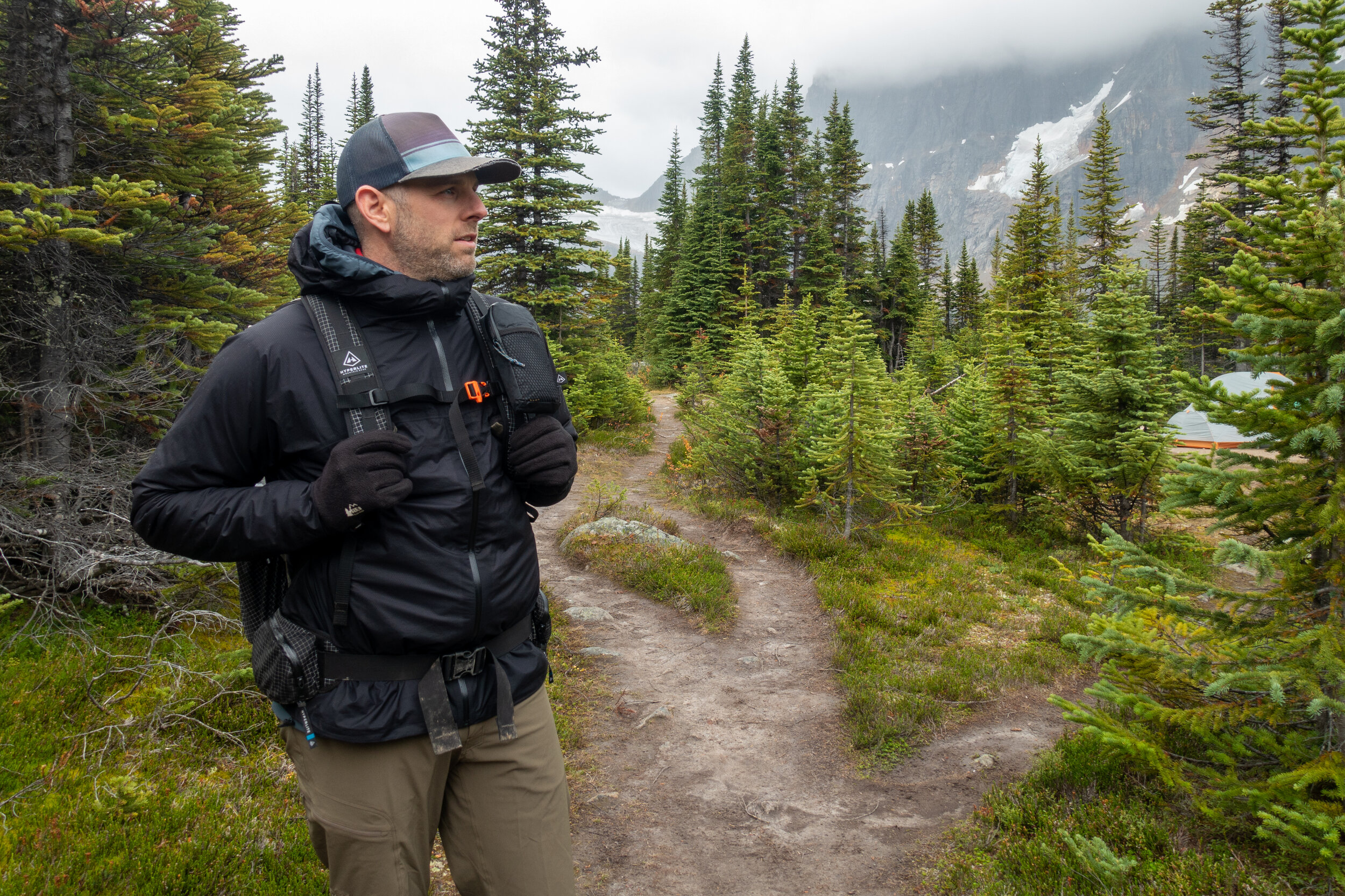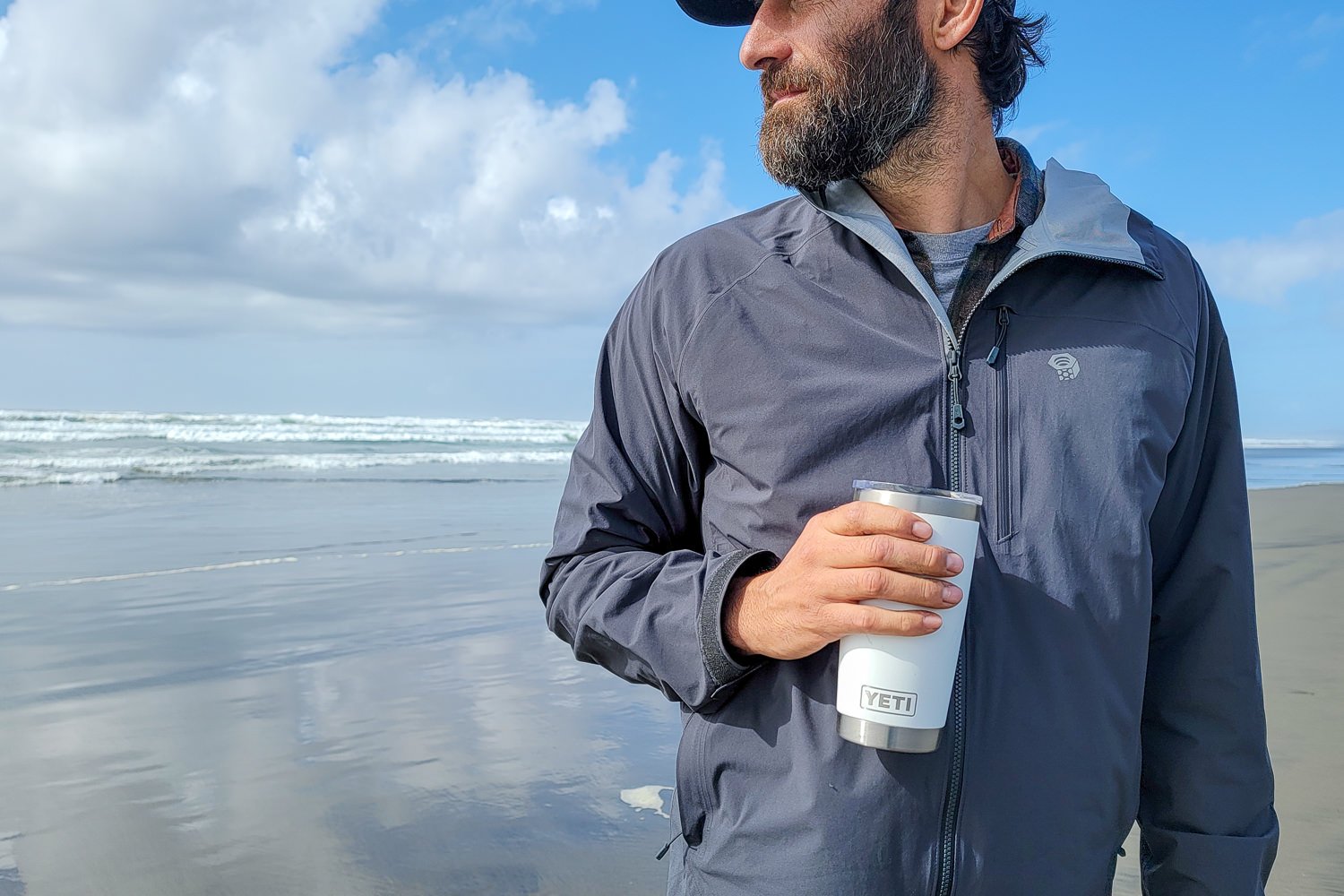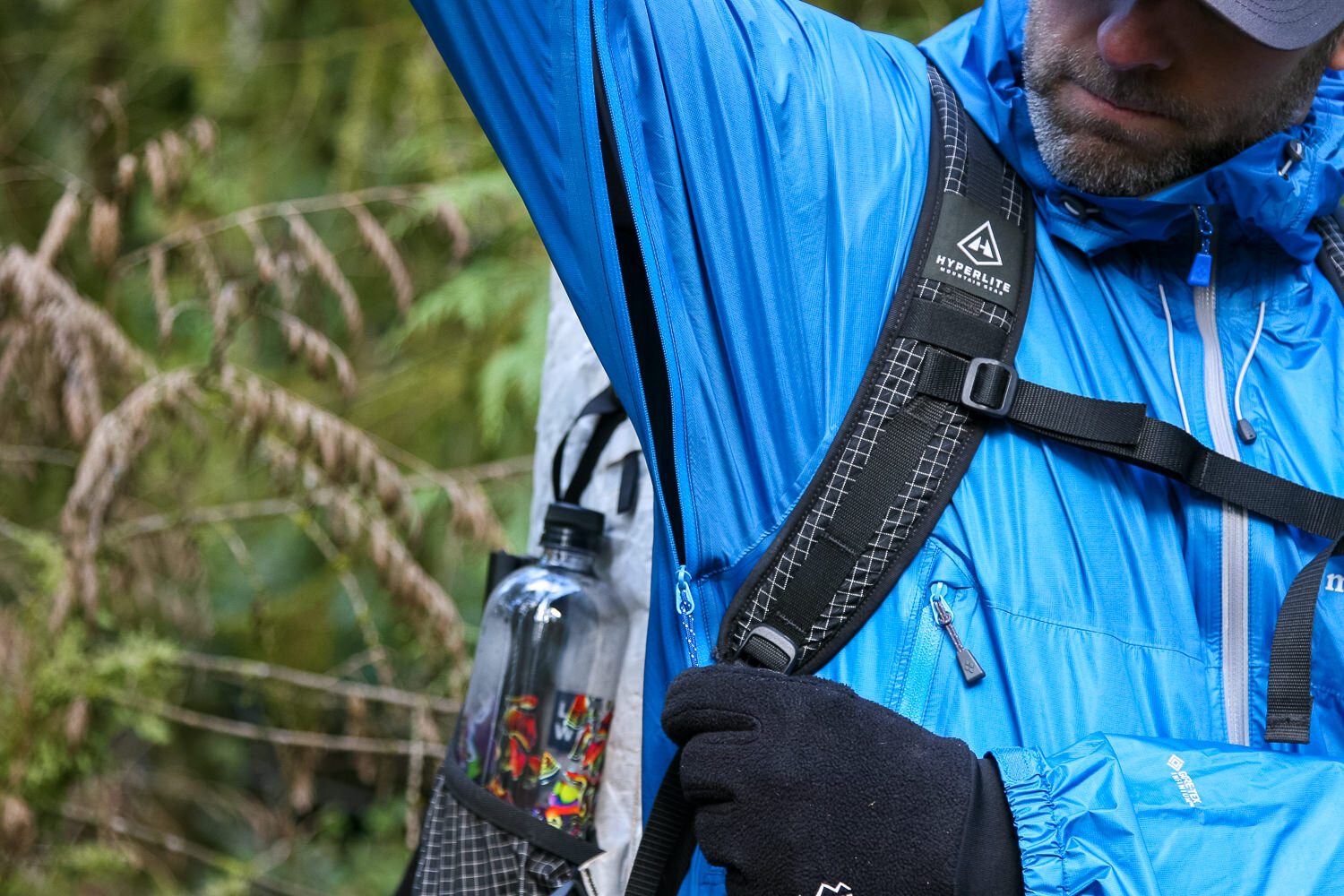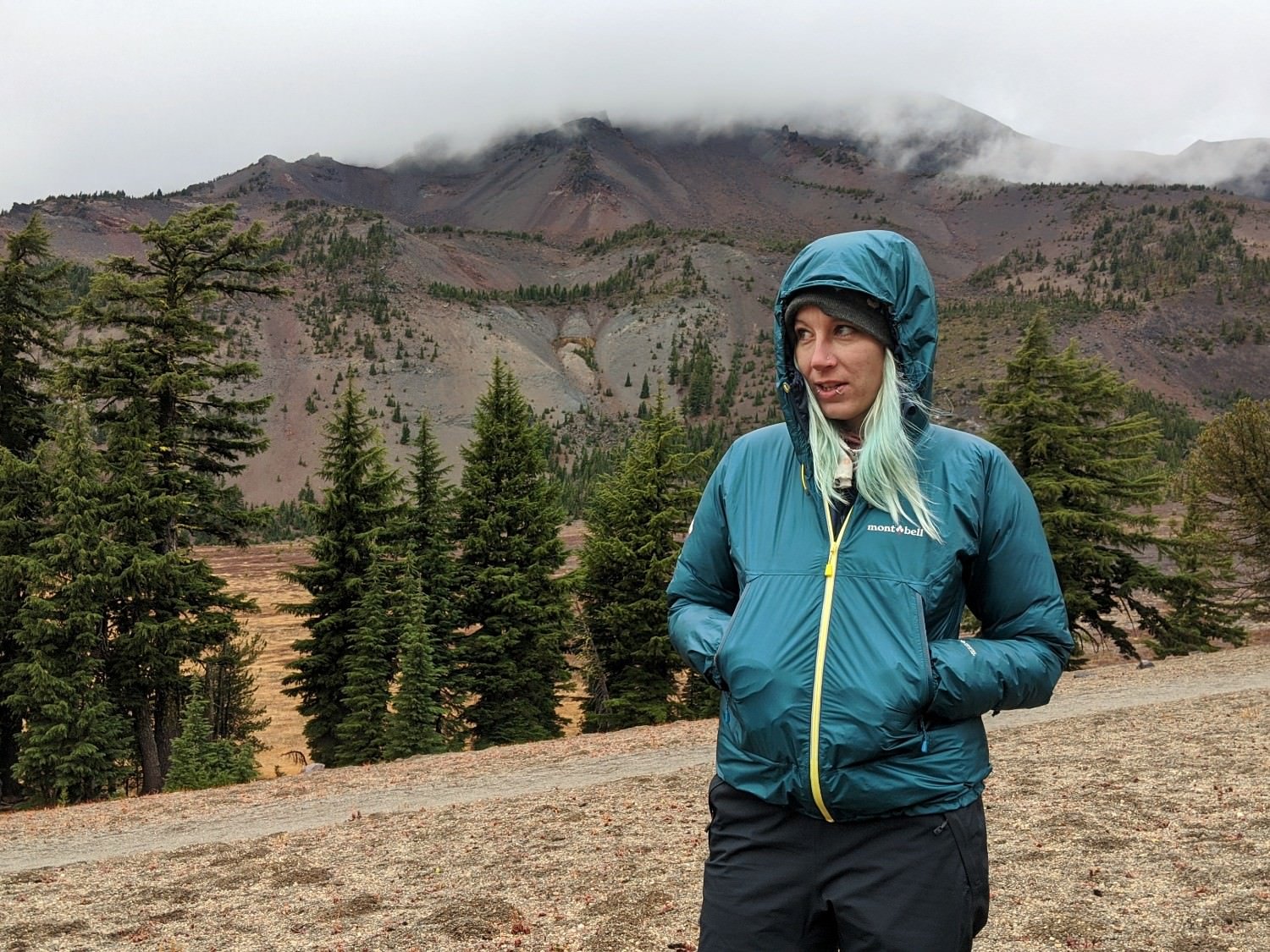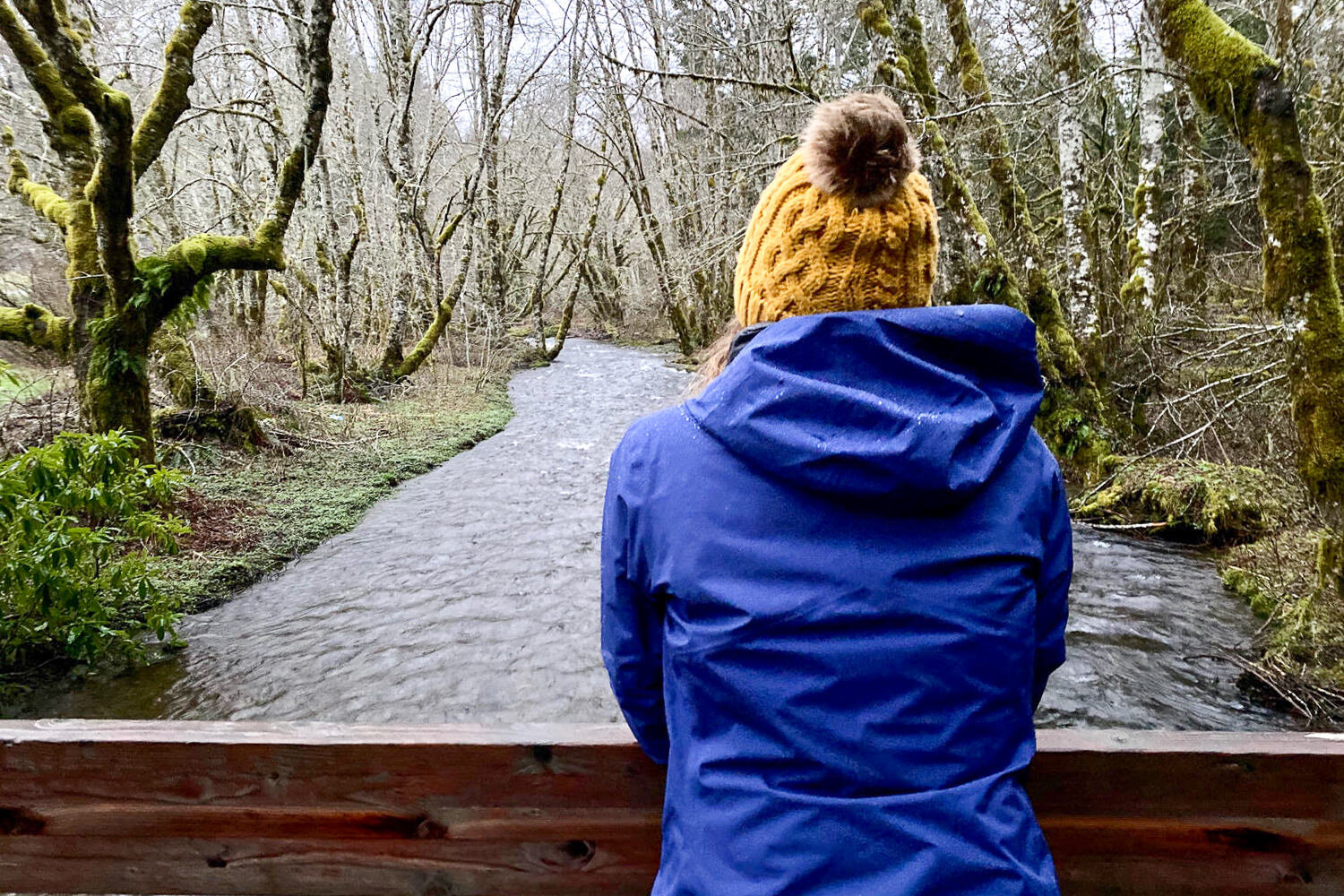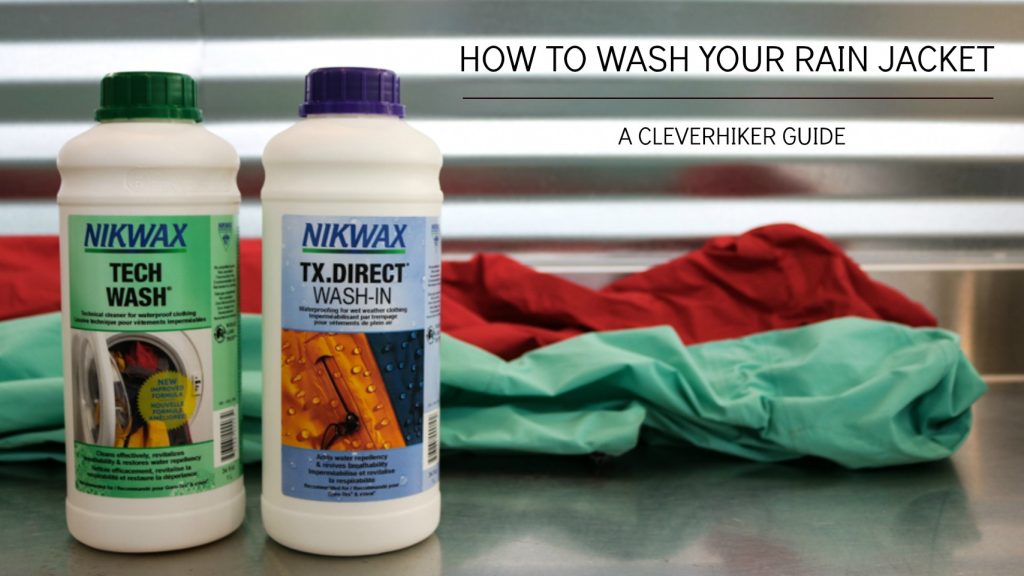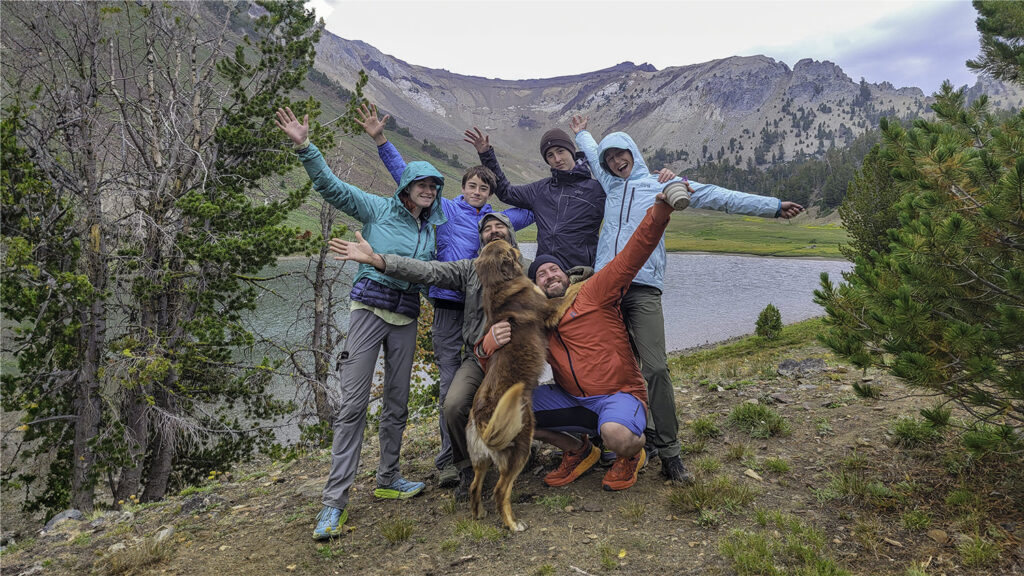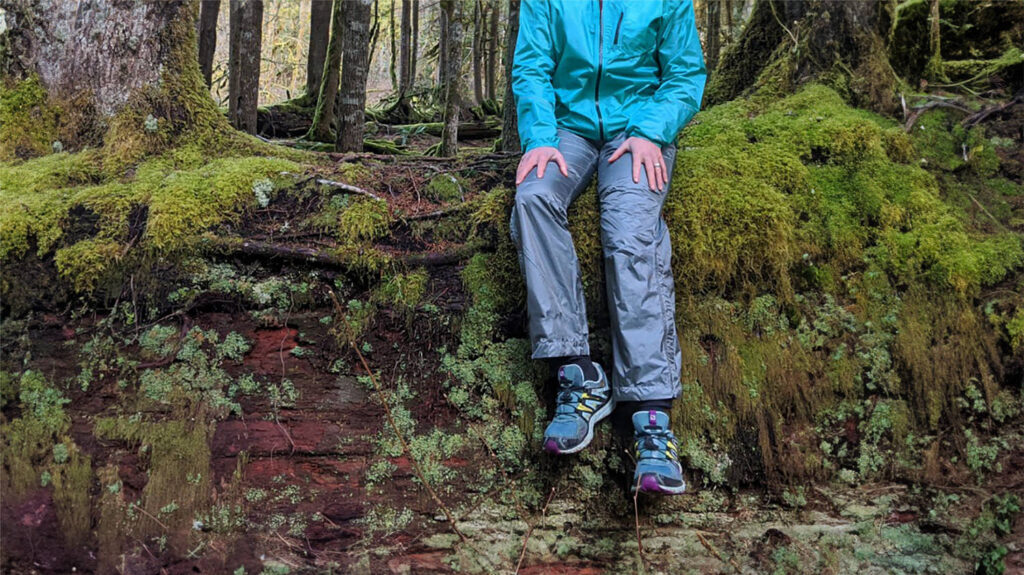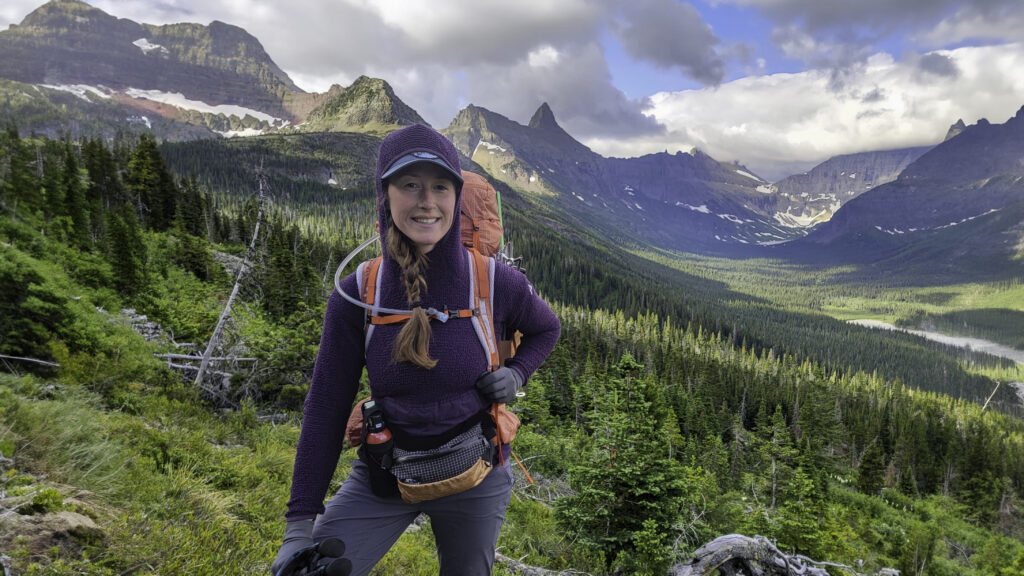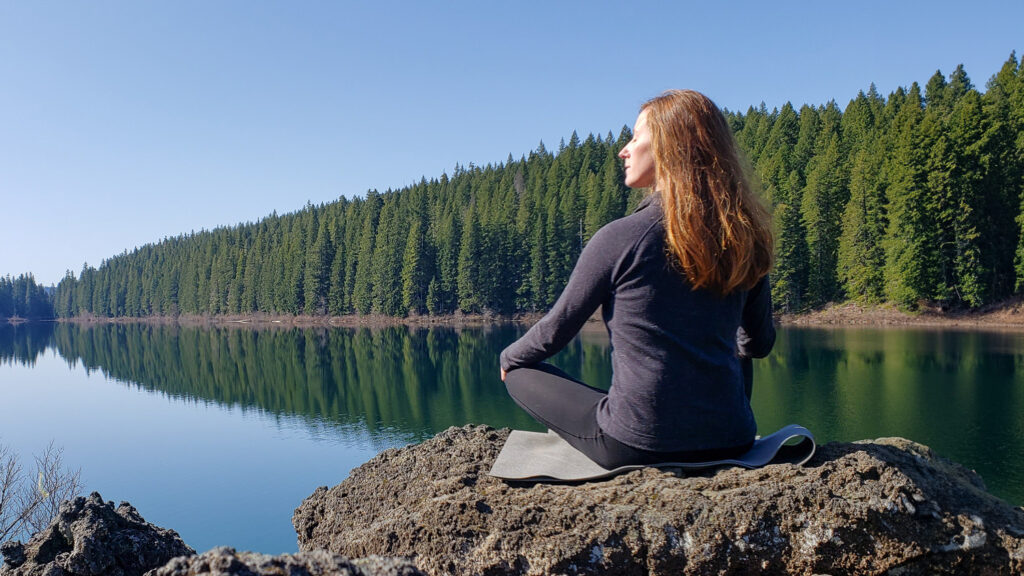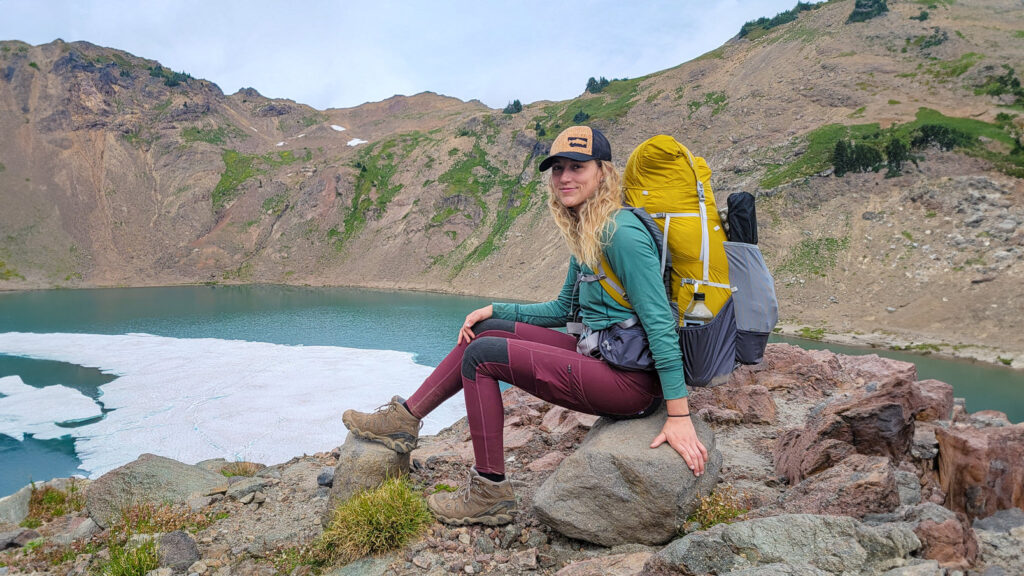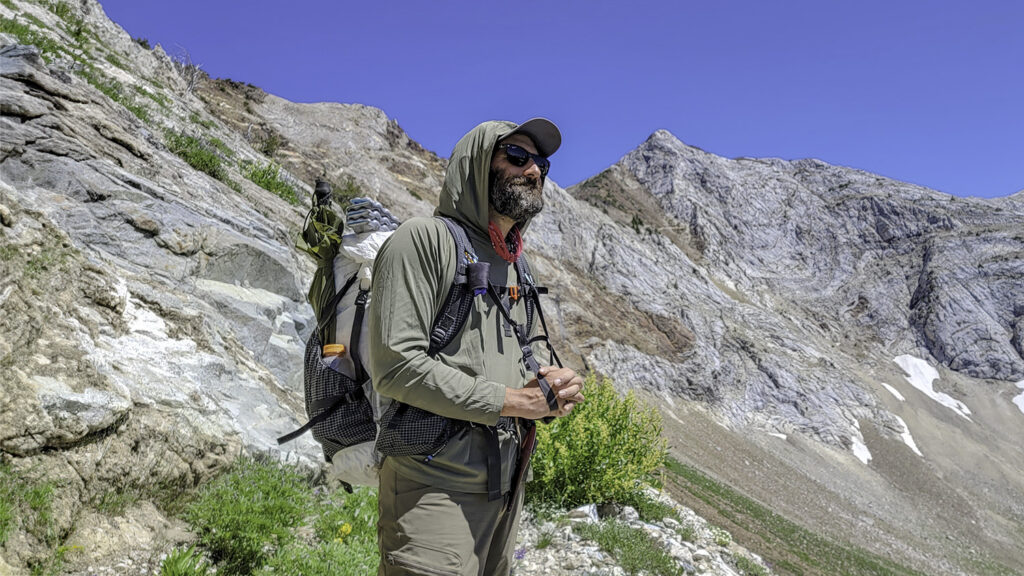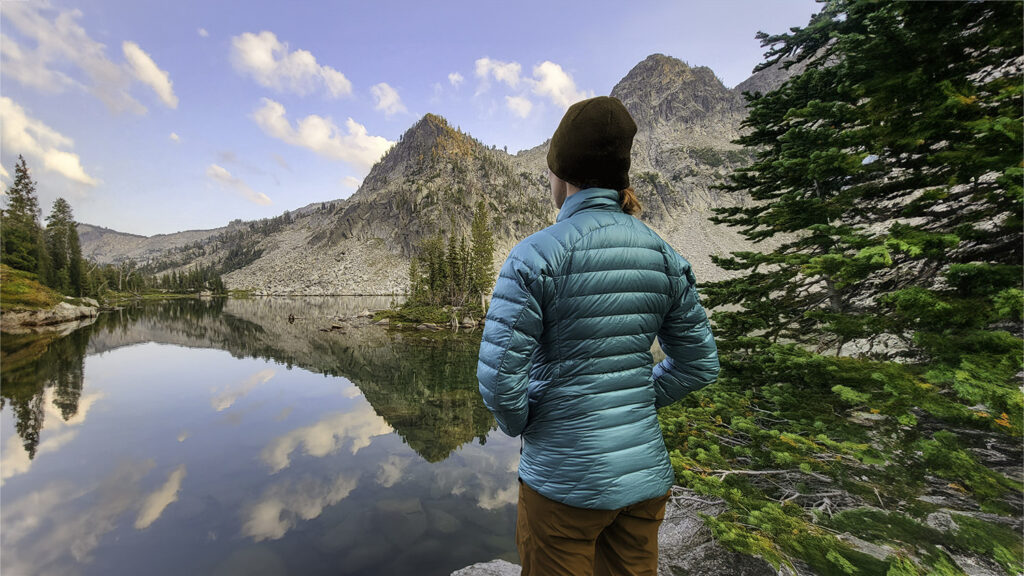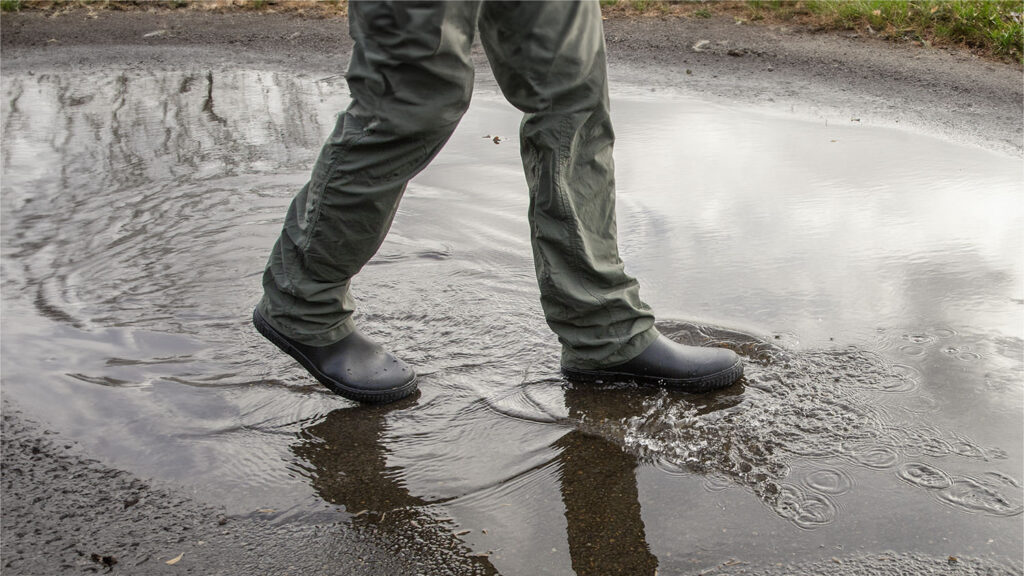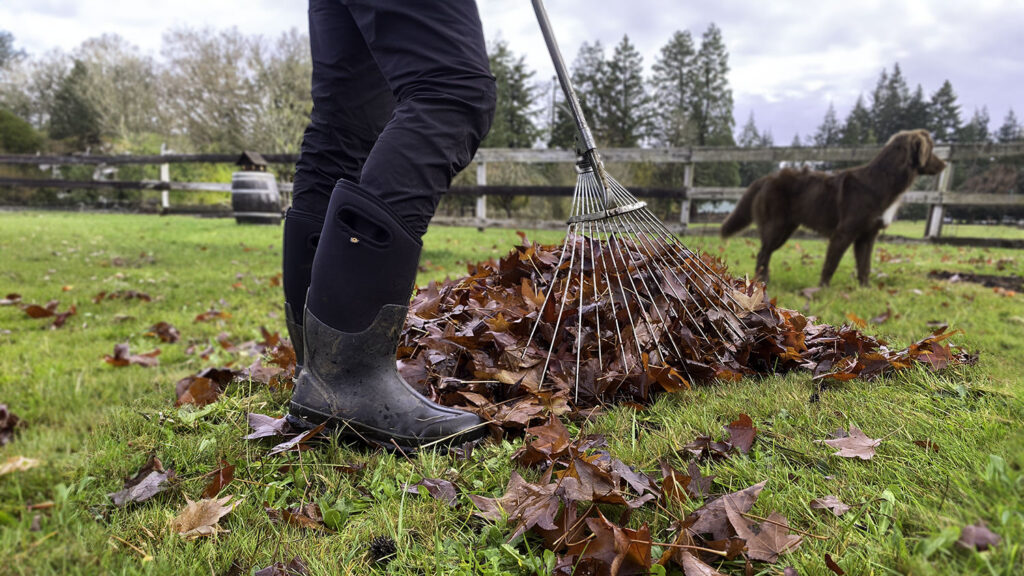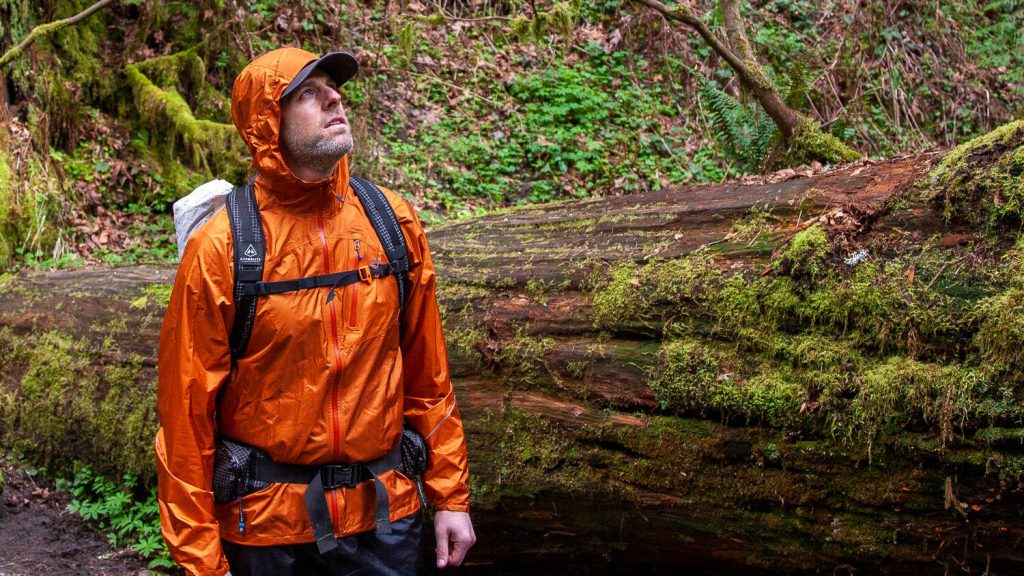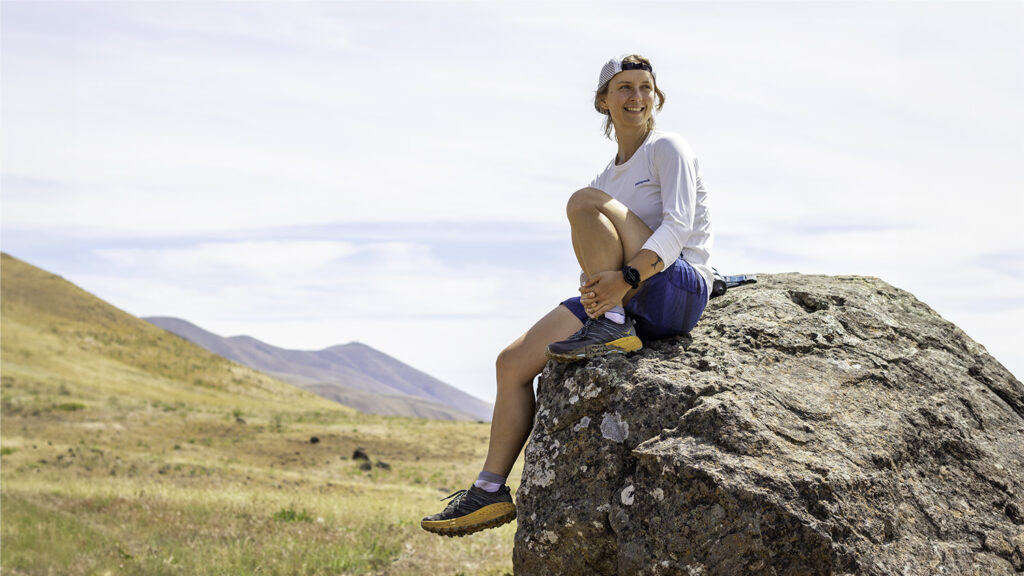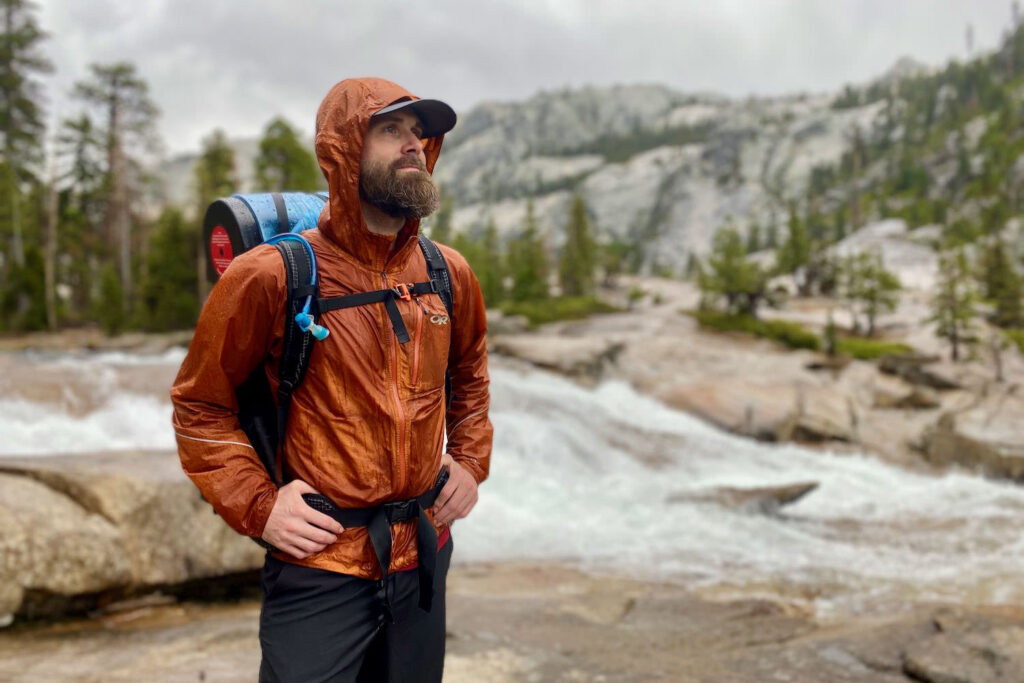
A quality rain jacket is a staple for any outdoor adventure: it will shield you from rain, wind, and cold, keeping you dry, warm, and comfortable. Our team of seasoned backpackers and dedicated gear buffs doesn’t just compare specs – we researched 80 models and have trail-tested more than 40 rain jackets over the past ten years from brands like Patagonia, Arc’teryx, REI, and Outdoor Research to see how they perform in real-world conditions.
From the rain forests of Oregon and the summer monsoons of the Rocky Mountains to the swampy and soggy Appalachians, we’ve put over 500 days of downpour to good use and whittled this list to the best of the best when it comes to rain protection.
If you prefer ponchos or umbrellas on trail, we’ve also picked out our top choices for each. And if you’ll be in really wet conditions, we recommend taking a look at our list of the top rain pants available. And if chilly days and nights are in the forecast, you’ll definitely want to layer up with one of our favorite fleeces or down jackets.
Quick Picks for Rain Jackets
Take a look at this quick list of our favorite rain jackets or continue reading to see our full list with in-depth reviews.
Best rain jacket overall: Patagonia Torrentshell 3L – Men’s / Women’s ($179)
Best rain jacket for ventilation: Outdoor Research Foray II – Men’s / Aspire II – Women’s ($225)
Best budget rain jacket: REI Rainier – Men’s / Women’s ($100)
Super comfortable rain jacket: Mountain Hardwear Stretch Ozonic – Men’s / Women’s ($230)
Best ultralight rain jacket: Montbell Versalite – Men’s / Women’s ($260)
Most protective rain jacket for wet conditions: Arc’teryx Beta – Men’s / Women’s ($400)
Breathable ultralight rain jacket: Zpacks Vertice – Men’s / Women’s ($299)
Lightweight & affordable rain jacket: Black Diamond StormLine Stretch – Men’s / Women’s ($180)
High value rain jacket: REI Flash Stretch – Men’s / Women’s ($169)
Most affordable ultralight rain jacket: Outdoor Research Helium – Men’s ($170) / Women’s ($180)
Affordable & versatile rain jacket: Marmot Precip Eco – Men’s / Women’s ($120)
What’s new
After many drizzly desert mornings and massive mountain thunderstorms, we’ve updated our list:
- The Outdoor Research Foray II (men’s) / Aspire II (women’s) are top contenders for their unrivaled ventilation, quality construction, and cool colorways.
- The Arc’teryx Beta (men’s / women’s) earns a spot thanks to its durable and quiet fabric and an excellent hood design.
- We added the brand new and super comfy REI Flash Stretch Jacket (men’s / women’s), a great choice for 3-season hiking thanks to an oversized fit and quick-drying fabrics.
- The affordable and practical Marmot Precip Eco (men’s / women’s) gets the nod as a less expensive comfortable rain jacket.
- We added suggestions for ponchos for hiking based on comfort, versatility, and packed size as well as our picks for the best umbrellas for hiking.
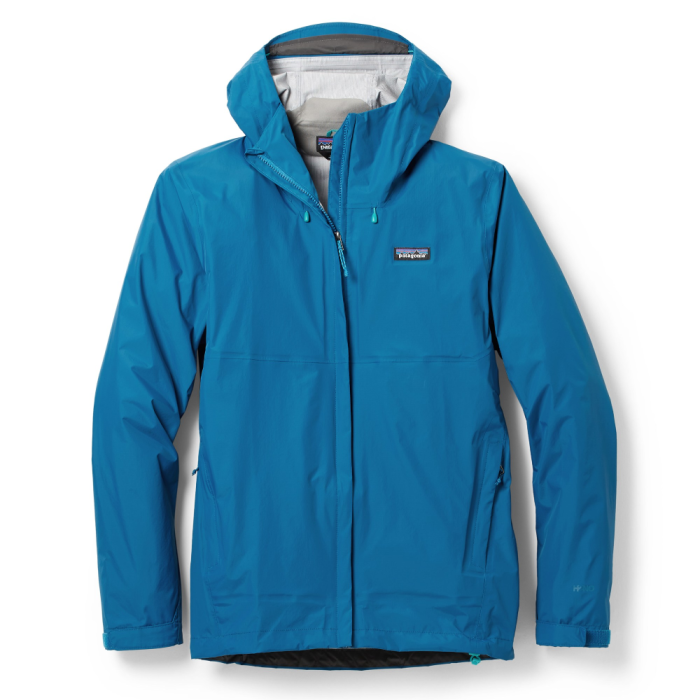
Patagonia Torrentshell 3L
Best rain jacket overall
Price: $179
Weight: 14.1 oz. (men’s) / 12.4 oz. (women’s)
Pros
- Durable materials
- High-quality construction
- Deep pockets
- Pit zips
- Stylish fit
- Strong hem & sleeve ties
- Packs small into its own pocket
- Hood rolls up
- Tons of colorways
Cons
- A bit heavy/bulky for extended backcountry trips
- A bit baggy in sleeves
- No external chest pocket
The Patagonia Torrentshell 3L (men’s / women’s) has been at the top of our list for many years, and for good reason. It’s one of our go-to rain jackets and all-time favorites. From 150-day thru-hikes of the CDT including torrential downpours, high-alpine blizzards, and drizzly fall weather, to trips skiing, camping, and hiking the local trails, this jacket is a durable, affordable workhorse.
The Torrentshell features laminated triple-layer construction that makes it protective in sustained rain, but still feels impressively lightweight on your body. The hood is adjustable and features a large visor to keep the rain out of your eyes and off your face, but it also rolls away easily with a cord and hook when not in use.
For a rain jacket, the Torrentshell is cozy. A soft microfleece lining at the neck adds a soft-to-the-touch feel and wicks away moisture with ease. This jacket has two hand warmer pockets as well as storm flaps – overlapping material that covers the main zipper and pit zips to help you stay dry.
Even though it’s a bit bulky, the Torrentshell still packs down small into the left hand warmer pocket and comes with a convenient carabiner loop so you can keep it easily accessible when the skies open up.
The only major complaint we have about the Torrentshell is its weight. At 14.1 ounces for the men’s version and 12.4 ounces for the women’s, there are other jackets on this list that are better suited for long-distance trips where shaving pack weight is important. So if you’re considering the Torrentshell exclusively for backpacking, we’d recommend other options on this list.
Though it’s not as airy or compressible as some, we highly recommend it for adventures when stormy conditions are inevitable. The Torrentshell is a versatile, reasonably affordable, and very durable jacket that we recommend for all-around use.
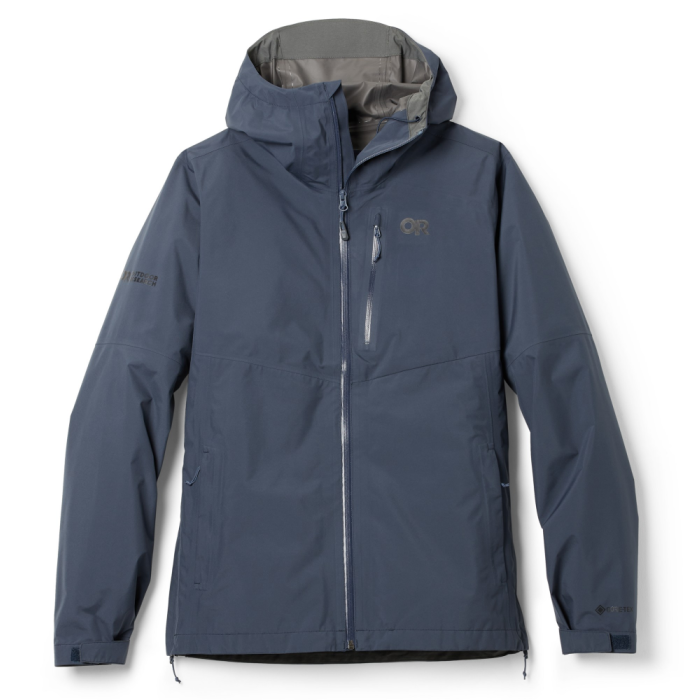
Outdoor Research Foray II / Aspire II
Best rain jacket for ventilation
Price: $225
Weight: 11.9 oz. (men’s) / 11.7 oz. (women’s)
Pros
- Extra-long pit zips for unrivaled ventilation
- Durable materials
- High-quality construction
- Deep handwarmer pockets
- External chest pocket
- Supple, flexible material
- Many colorways
- Packs small into its own pocket
Cons
- A little pricey
- A bit tight for those with wide shoulders
Thanks to excellent ventilation and smart design details, the Outdoor Research Foray II (men’s) / Aspire II (women’s) earns a spot at the top of our list. This jacket offers some of the best ventilation on the market, top-tier wind and rain resistance, and a stylish cut. CleverHiker Managing Editor, Ben Applebaum-Bauch, has used the Foray II on dozens of day hikes from the iron skies of Michigan to the rugged high alpine of the Colorado Rockies, it’s one of his go-tos for wet weather, and it continues to perform season after season.
If you’re looking for a jacket with breathability, the Foray and Aspire take ventilation to the next level. We love rain jackets with large pit zips for their breathability, but these Outdoor Research models have zippers that extend from the armpit all the way to the bottom hem. This versatile design allows you to completely unzip the jacket down your torso for extreme, poncho-style ventilation, or very precisely control how much airflow you want to keep your entire upper body cool.
Details matter when it comes to performance gear, and the Foray and Aspire are no exception. A simple hood drawcord is well placed and easy to reach, and large hem drawstrings make micro-adjustments a breeze while on the move. We love that the Foray and Aspire’s cuffs offer both elastic and large Velcro tabs for use with bulky gloves.
We found the fit is a bit tight through the shoulders, so if you’ve got a broad or wide build, you’ll want to double-check sizing. And though this jacket is a little pricey, you’ll be hard-pressed to find a better value for a relatively lightweight, super-breathable option. When the weather begins to turn and the skies open up, this jacket is a stellar option for staying both dry and well-ventilated.
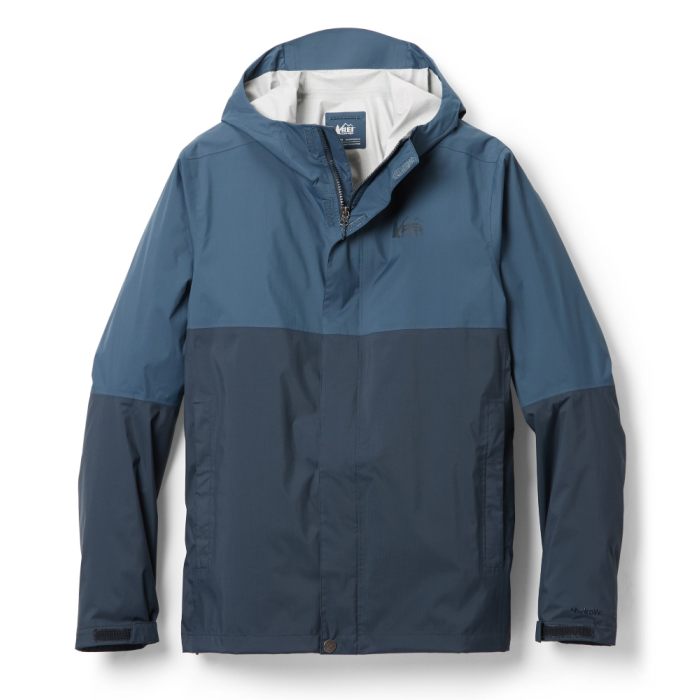
REI Rainier
Best budget rain jacket
Price: $100
Weight: 11.3 oz. (men’s) / 9.9 oz. (women’s)
Pros
- Affordable
- Lightweight
- Button at bottom of zipper flaps keeps rain out
- Lots of colorways
- Deep zippered handwarmer pockets
- Pit zips
- Packs into itself
- Oversized hood
Cons
- Less durable than others
- No external chest pocket
- A bit challenging to pack into stash pocket
The REI Rainier rain jacket (men’s / women’s) has been a favorite of hikers, backpackers, and our team at CleverHiker for a long time. For only $100, this jacket offers a stellar value: it’s well-designed and balances light weight and weather protection. The Rainier has been one of our favorite jackets as a team over thousands of miles on trail, from day hikes in the Cascades to weeks at a time in the Colorado Rockies, and it has performed extremely well.
The Rainier covers all the basics and adds small details we love. Articulated elbows offer a better range of motion with layers on, there are two internal drop pockets – unlike many jackets, which have one (or none) – and the hood is adjustable with a large Velcro tab that’s easy to manipulate even when your hands are wet and cold. Plus, it has pit zips and a practical drawstring hem.
The Rainier offers a slim but modern style, so it doesn’t look out of place whether you’re headed to the local brewery after walking the dog under dreary skies or backpacking on a stormy weekend. We appreciate that the newest version is a bit quieter thanks to a refreshed nylon blend, and the Rainier comes in an array of colorways, from brighter to muted and mellow for every style.
The cons of the Rainier are few. At its price point, it’s a little less durable than burlier models but we have gotten several seasons of use from different versions. It’s also a bit cumbersome to stash into its own pocket, although it makes for a fairly compact package once all the material is collapsed.
The Marmot PreCip Eco is almost identical to the Rainier. Both are great budget jackets, but we slightly prefer the Rainier for its wider availability, quieter fabric, slimmer fit, and better price point.
When you’re heading into drizzly and damp conditions, exploring a new route with friends, or knocking out a few dozen miles of backcountry trail, the Rainier is an excellent rain jacket at a stellar price.
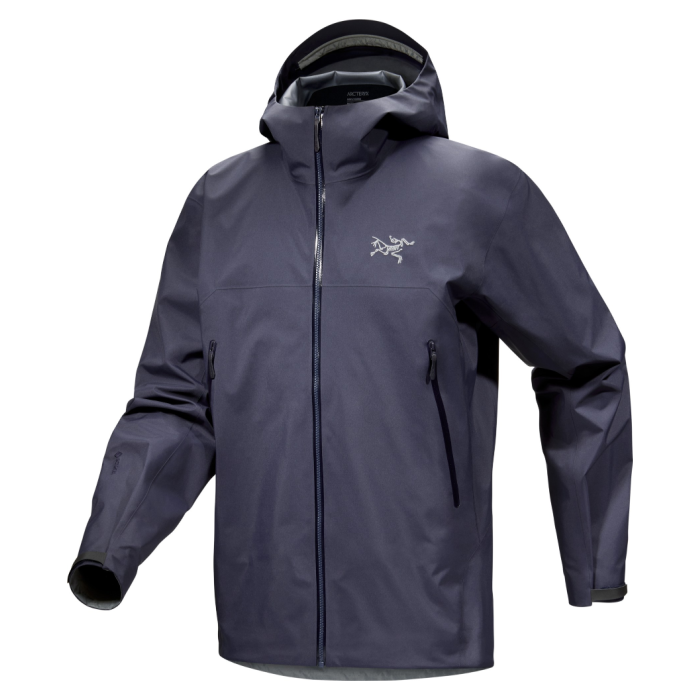
Arc’teryx Beta
Most protective rain jacket for wet conditions
Price: $400
Weight: 10.6 oz. (men’s) / 9.5 oz. (women’s)
Pros
- Durable materials
- Highest quality build
- Smart hood design
- Hipbelt compatible pockets
- Pit zips
- Quieter fabric
- Excellent in downpours
Cons
- Very expensive
- No storm flaps over zippers
- Slim fit isn't for everyone
The Arc’teryx Beta (men’s / women’s) is a top choice for its superior waterproofing. From the rigors of everyday on-off wear to keeping you dry in the gnarliest, wettest rainstorms (or even alpine blizzards), this is the only shell you’ll need for staying dry in nasty weather.
If you’re undeterred by extreme wet conditions, the Beta jacket is for you. This model’s three-layer Gore-Tex fabric sheds water easily and feels durable in heavy rain, sideways sleet, and whipping snow – and the newly redesigned Beta is now produced without PFAS, which translates to less pollution during production and a more mindfully-made jacket. The drop hem at the back effectively directs and sheds water away from your body as you move. We also appreciate the ergonomic, oversized zippers that are easy to grasp even with bulky gloves on.
The Beta stands out for its dialed-in design: the fabric feels impenetrable, but the fit is roomy enough at the shoulders and elbows to move naturally with you. We find this athletic construction performs admirably on the toughest alpine days where every detail matters. CleverHiker Gear Analyst, Ian Krammer, has used this jacket as his go-to shell to climb hundreds of 13,000-foot Colorado peaks in frigid winter conditions and has also used it in soaking July thunderstorms while climbing in the Rocky Mountains.
We also love the hood design of the Beta. Its high internal collar blocks wind and rain by locking in snugly under the chin, and helps retain a bit of extra warmth in cold, pressing wind. The overlapping hood adjustments fit precisely and snugly around your face, and the wide visor keeps even driving, sideways rain at bay. The hood is helmet-compatible, but it doesn’t feel floppy on its own.
The biggest downside of the Beta is its price tag. This is one of the most expensive jackets we’ve ever tested. The Beta is also bulky compared to other options on this list – it doesn’t pack down well, and this model certainly isn’t the lightest out there.
That said, heft is a small con in the face of serious storms, and this is the jacket our team trusts most in severe rain and snow conditions. And if your use case is a little different, the Beta also comes in an insulated version (men’s / women’s) and lightweight version (men’s / women’s).
The Beta is worth the investment for those who need a rain jacket that will last season after season of hard use in wet weather. If you’re on the hunt for a technical rain jacket that can truly do it all, this is the one.
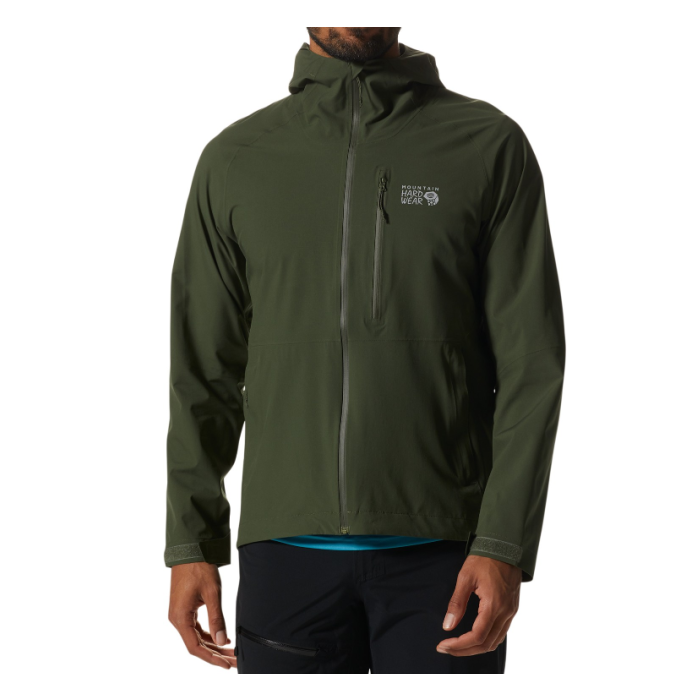
Mountain Hardwear Stretch Ozonic
Super comfortable rain jacket
Price: $230
Weight: 10.7 oz. (men’s) / 9.9 oz. (women’s)
Pros
- Stretchy & comfortable
- Lightweight
- Quieter fabric
- Large chest pocket
- Deep handwarmer pockets
- Large pit zips
- 2 adjustable hem cords
- Packs small into itself
Cons
- Hood visor isn’t as wide or long as some
- Velcro cuffs are thin & less sticky
If comfort is your top priority, you’ll love the Mountain Hardwear Stretch Ozonic Rain Jacket (men’s / women’s). This versatile coat offers soft-to-the-touch fabric, practical pockets, and excellent waterproofing for trekking rugged trails.
The Ozonic continues to be one of the most comfortable jackets on our list – that’s why it stays near the top. CleverHiker Gear Analyst, Heather Eldridge, has worn this jacket on hundreds of day hikes because the stretchy fabric is soft to the touch and gives a relaxed, unrestricted feel that’s easy to move in. And thanks to the breathable fabric, the material is impressively quiet – you can actually hear what your friends are saying with the hood up!
The Ozonic has all the key elements we look for in a rain jacket: hand pockets, two-way hood adjustment, and pit zips, so it’s great for just about any activity. We also love its low weight. At 10.7 ounces for a men’s medium, the Ozonic is near the front of the pack, making it easy to carry, wear, and stuff away.
That said, this Mountain Hardwear classic has a couple of quirks. We find the fit is a bit unusual: it’s baggy through the torso and the sleeves are on the shorter side. However, the major advantage of this looser fit is that it’s great for layering. If you love cooler-weather adventures where rocking a fleece and puffy is vital for comfort, you’ll have no trouble fitting warm layers underneath the Ozonic.
More than anything, we reach for the Ozonic because of its outstanding comfort, trendy profile, and trusty waterproofing. This jacket will shield you from windy, misty mountain summits and downpours alike.
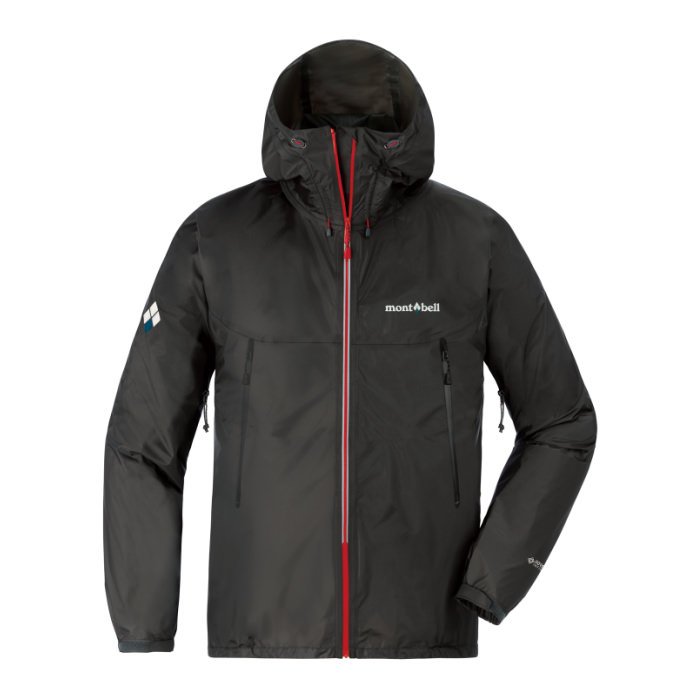
Montbell Versalite
Best ultralight rain jacket
Price: $260
Weight: 6.4 oz. (men’s) / 5.8 oz. (women’s)
Pros
- Ultralight
- Packs very small
- Highly adjustable hood
- Excellent feature set
- Pit zips
- Stretchy & Velcro cuffs
- Hipbelt-compatible pockets
Cons
- No chest pocket
- Delicate material
- Slim fit isn't for everyone
When it comes to water resistance, the Montbell Versalite (men’s / women’s) is one of our all-time favorites for thru-hiking and ultralight adventures. This is CleverHiker Founder, Dave Collins’ go-to ultralight shell for backpacking and he’s used it for thousands of miles, from the Grand Sawtooth Loop in Idaho to the Glacier Peak wilderness. Gear Analyst, Casey Handley, also loves the Versalite, and it kept her dry and well-ventilated on a very soggy 273-mile thru hike of the Long Trail in Vermont.
If you’re looking for a truly airy shell to stay dry in short summer storms, this is the one. The men’s Versalite weighs a jaw-dropping 6.4 ounces, and the women’s is only 5.8 ounces. For perspective, that’s approximately the weight of two protein bars. And, it packs down to a very small package – about 3 by 3 by 5 inches – so this model easily slips into any pack without taking up much space.
Despite its incredibly low weight, the Versalite is as feature-rich as any jacket on this list. We love the three-way, super-adjustable hood and tall neck, the combination elastic and Velcro cuffs, and the extra long pit zips for dialed-in ventilation. The oversized hand pockets are higher up on the body to give unrivaled accessibility to pockets while wearing a climbing harness or thick backpack hipbelt, so you won’t have to unclip your backpack while walking to reach your chapstick or phone.
As with most ultralight gear, the Versalite sacrifices durability. It’s made with thin, featherlight materials, so you’ll have to be more careful with it than you would with a burlier jacket. It is also a little more crinkly and noisy than others. That said, we’ve been using this jacket for years without any notable issues and we think the dramatic weight savings makes it one of the best choices for long-distance backpacking.
While it’s on the spendy side, the Versalite is a very competitive price for a premium ultralight jacket. We highly recommend the Versalite to anyone who is looking for a minimalist layer with maximum functionality for a very low weight.
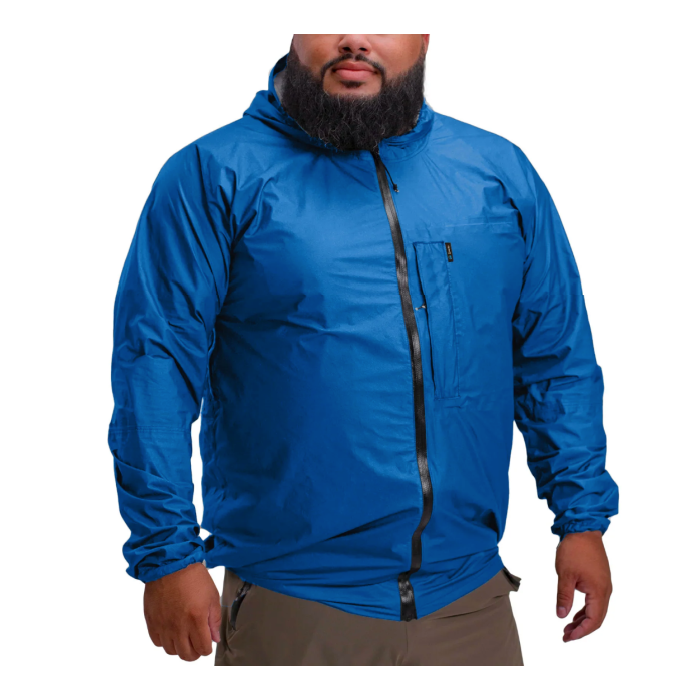
Zpacks Vertice
Breathable ultralight jacket
Price: $299
Weight: 5.75 oz. (men’s) / 5.7 oz. (women’s)
Pros
- Ultralight
- Large chest pocket
- Pit zips
- Adjustable sleeves, hem & hood
- Hood rolls away
- Packs very small
- Fit accommodates layers well
- Excellent coverage
Cons
- Expensive
- No handwarmer pockets
- Oversized hood works best with hat
- Less durable
The Zpacks Vertice (men’s / women’s) is one of the lightest rain jackets available. Despite its featherweight status, this shell performs: it provides excellent protection in pouring rain, but remains impressively breathable. CleverHiker Senior Gear Analyst, Casey Handley, hiked the first 400 miles of the Colorado Trail in one of the wettest springs in the last decade and appreciated its long length and durability.
At about six ounces, the Vertice is in a league with the Montbell Versalite and the Outdoor Research Helium for ultralight jackets. Like the others, this one packs up incredibly small, so it’s ideal for long day hikes and thru-hikes where space and weight are the top priority.
The length of the Vertice is what sets it apart: this model is long enough to cover your bum, which is convenient when taking breaks on wet rocks or logs. It also means the seat of your shorts or pants won’t bear the brunt of the runoff from your jacket, so you’ll stay a little warmer when it’s wet out, and hopefully dry a bit faster.
The Vertice doesn’t skimp on any details either: ZPacks includes long pit zips, simple drawcords on the wrists, hem, and hood, and a handy mechanism for rolling up the hood when storms pass. The Vertice is also one of the most breathable jackets on our list, so it won’t cause you to overheat immediately when backpacking through the early afternoon rain.
That said, the Vertice is built for function in the backcountry, not fashion in the city. It has a baggier fit, so it’s best for larger body types and those who like a longer jacket. We also miss not having handwarmer pockets and the hood is a little floppy.
Like most ultralight gear, the Vertice is also on the spendy side, but if you want the best balance of low weight, crazy packability, and excellent coverage – this one is hard to beat. As long as you give it the care and attention it needs, the Vertice will last for thousands of miles.
Full review: Zpacks Vertice
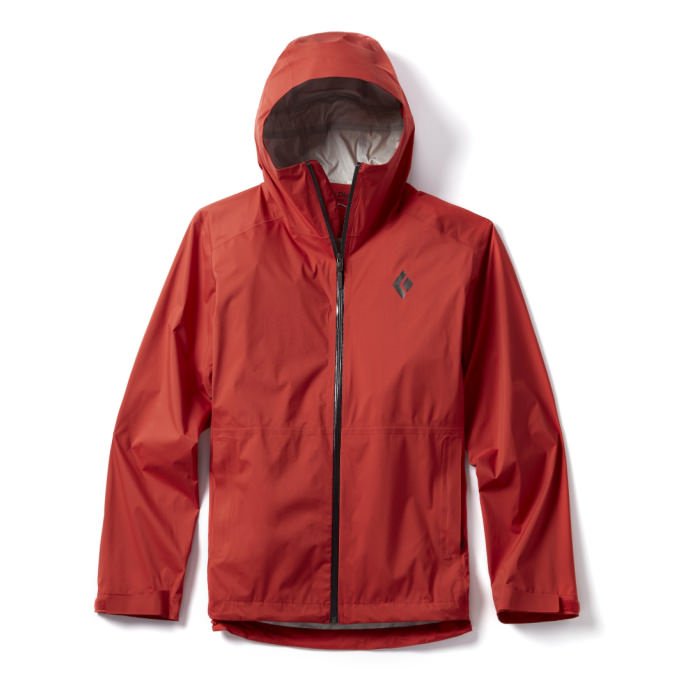
Black Diamond Stormline Stretch
Lightweight & affordable rain jacket
Price: $180
Weight: 11.3 oz. (men’s) / 9.5 oz. (women’s)
Pros
- Less expensive
- Lightweight
- Packs small into its own pocket
- High-quality construction
- Internal collar
- Pit zips
- Tons of colorways
Cons
- High collar & helmet compatible hood isn't for everyone
- No chest pocket
The Black Diamond StormLine Stretch jacket (men’s / women’s) hits the nail on the head for a great balance of affordability, high-quality construction, and useful features. If you’re looking for a savvy all-around jacket for backcountry hiking, the StormLine is up for the task.
It’s full of simple details that give it exceptional value. The long pit zips help with ventilation and the stretchy Velcro cuffs make the jacket easy to use with gloves on. The helmet-compatible hood is simple to adjust, and the tall collar is excellent at keeping out drafts and drips. We also love the wide variety of colorways available for the StormLine – whether your vibe is neon, pastel, or more muted, there’s probably a color for you.
The StormLine’s material and fit are our favorite things about it. This model offers a regular-to-slim fit, with just enough stretch and gusseted armpits for mostly unrestricted big movements. The StormLine’s aesthetic is sleek enough to wear out to dinner on a stormy summer night, or for keeping you dry while setting up your tent in a misty frontcountry site.
However, this jacket is a bit further down the list largely because of its pocket design. We found the handwarmer pockets are a bit shallow, and positioned too low to access with a backpack or harness on. This model also doesn’t include a chest pocket.
Overall, the StormLine is a highly functional and attractive jacket that packs easily into an impressively small package for portability. Because of the thoughtful design and the affordable price point, the StormLine is one of the most well-rounded rain jackets on the market.
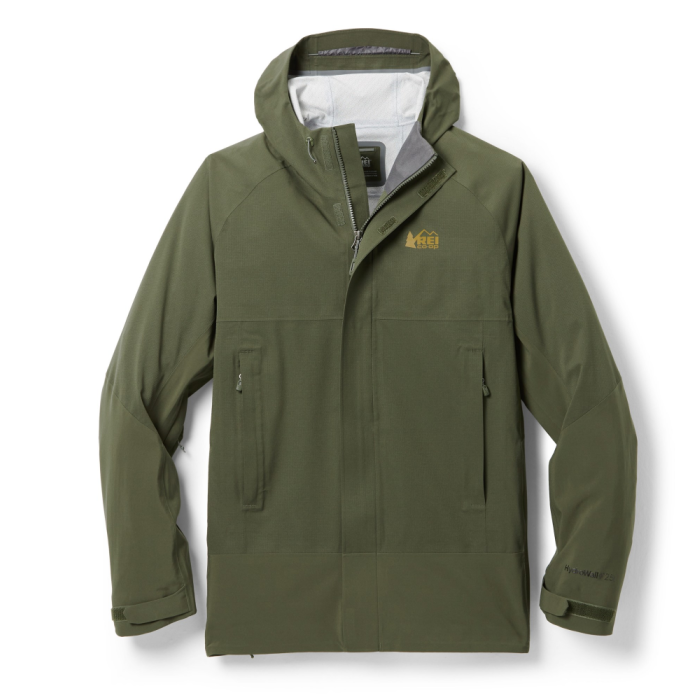
REI Flash Stretch
High value rain jacket
Price: $169
Weight: 17 oz. (men’s) / 14.5 oz. (women’s)
Pros
- Durable materials
- Excellent stretch
- High-quality construction
- Easy to layer
- Deep pockets
- Chest zipper
- Long pit zips
- High zippers compatible with harness
Cons
- Baggy / oversized fit
- Short visor on hood
- Long sleeves
- Heavy / bulky for extended trips
The REI Flash Stretch Rain Jacket (men’s / women’s) is an ultra stretchy and feature-forward jacket with a stellar balance of affordability and quality.
REI doesn’t skimp on any of our favorite features with the Flash Stretch: pit zips are plenty long enough to dump heat when you’re out of breath and moving through an afternoon rainstorm, and the hood offers three-way adjustments for a nuanced fit even while wearing a hat or helmet. It includes high-position handwarmer pockets for easy access while using a backpack, plus a large chest pocket for small storage. We also like that all the zippers have wide rain flaps to block the rain from dripping in.
We find the Flash Stretch is as cozy as rain jackets get. The polyester and spandex blend feels soft against the skin, and brushed polyester patches at the collar and chin are a nice touch when the hood is up and chilly wind is blasting. This jacket quickly became one of our go-tos for protection on short day hikes simply because it’s so comfortable.
The fit is baggier compared to other jackets, so it’s best for those who prefer a relaxed fit. However, the Flash Stretch is a perfect candidate for adding insulation layers – there’s plenty of room for a puffy or mid-layer underneath, and you won’t sacrifice a bit of extra mobility for that added warmth.
One drawback is that this jacket is one of the heaviest and bulkiest we tested. A smidge over a pound for the men’s Large makes the Flash Stretch one of our last picks for multi-day backpacking trips. That said, this REI model is a great option for daily wear and day hikes where weight isn’t a huge concern.
However, between the soft material, durable build, and excellent waterproofing, the Flash Stretch is a great option for everyday wear, whether you’re at an outdoor concert or heading into a rainy weekend of camping.
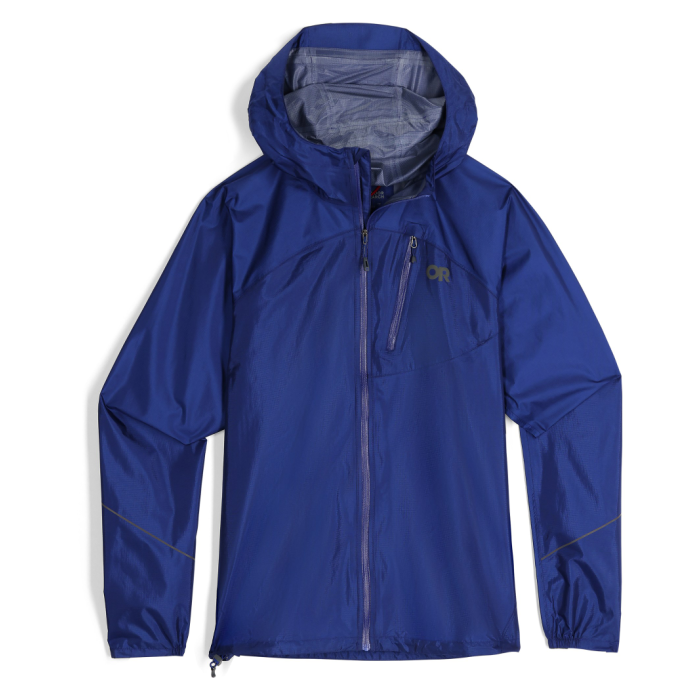
Outdoor Research Helium
Most affordable ultralight rain jacket
Price: $170 (men’s) / $180 (women’s)
Weight: 6.2 oz. (men’s) / 6.3 oz. (women’s)
Pros
- Ultralight
- Less expensive
- Packs down very small
- Key clip in hand pocket
- Angled chest pocket
- Handwarmer pockets in women’s version
- Adjustable hood
- Many colorways
Cons
- No pit zips
- No hand pockets in men’s version
- No cuff tightening systems
When it comes to ultralight jackets, the Outdoor Research Helium (men’s / women’s) is one of the most practical options on the market. While it weighs almost the same as the ZPacks Vertice and the Montbell Versalite – just over six ounces – it’s less expensive and offers many of the same features.
CleverHiker Managing Editor, Ben Applebaum-Bauch, hiked the 3,000-mile Continental Divide Trail in this jacket and it held up well in most storms with plenty of room underneath for a lightweight down puffy. CH Gear Analyst, Heather Eldridge, also spent a week backpacking in Glacier National Park with this jacket and had no complaints – it kept both of them dry, comfortable enough, and it took up little space.
The Helium has a large chest pocket that makes access to small items easy and fast. This pocket is also the carrying case for the Helium, and it packs down into one of the smallest, most efficient packages on this list, perfect for backpacking and fastpacking.
This jacket is fairly thin and will wet out faster than others in really heavy rain, especially where backpack straps sit. Also, the men’s version doesn’t have handwarmer pockets, which we’ve found inconvenient on and off trail. This isn’t a dealbreaker for us, but we’d prefer the extra storage like the women’s version – instead, we bring waterproof gloves on cold, wet trips.
All-in-all, you cannot beat the price-to-weight ratio of the Helium. If keeping your overall pack weight low on long summer hikes is important to you, or you need a basic layer for cloudbursts and occasional summer storms, the ultra-packable Helium offers a stellar bang for your buck.
Full review: Outdoor Research Helium
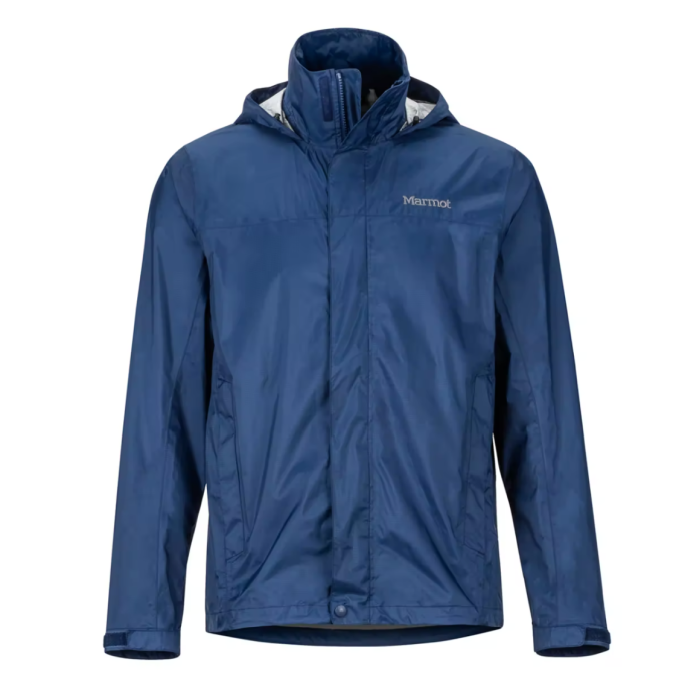
Marmot Precip Eco
Affordable & versatile rain jacket
Price: $120
Weight: 11 oz. (men’s) / 9 oz. (women’s)
Pros
- Deep pockets
- Pit zips
- Stowable hood
- Storm flaps over zipper help keep moisture out
- Higher pockets for hipbelt
- Less expensive
- Internal collar
- Many colorways
Cons
- Internal laminate lining is less durable
- Hood isn’t as adjustable
- Zipper pulls are small
- No chest pocket
- Wets out faster than more durable options
If you’re looking for a less expensive jacket for summer storms, the Marmot Precip Eco (men’s / women’s) offers a practical design, reliable water protection, and stylish colorways.
This Marmot model has plenty of features we look for in a quality rain jacket. The wide storm flap over the zipper helps keep moisture out. The internal collar is tall, and the wrap-around hood design offers a bit of extra protection when wind and rain are picking up. The hood rolls up and stows away and like other jackets on this list, it packs up into itself.
Some jackets are simply too technical-looking to transition easily into everyday life, but not the Precip Eco. This stylish jacket fits right in on the sidelines of your kids’ soccer game or a morning coffee date, but still lends an efficient, water-resistant layer when storms are moving through. We love the retro colorways Marmot offers, but the Precip also comes in neons, solids, and muted shades to compliment any style.
It performs well in light and medium rain, which makes it ideal for three-season storms. CH Gear Analyst, Casey Handley, used the Precip on her thru-hike of the 2,200-mile Appalachian Trail and it saw a ton of use. She stayed reliably dry for the first 1,000 miles and then began to wet out faster than other jackets on this list.
The cons of the Precip mostly come down to long-term durability. We find the fabric of this Marmot model is a bit noisy, the laminate lining begins to crack and flake after a few seasons, and reapplications of DWR are needed sooner than later. That said, for only $120, this Marmot classic is wallet-friendly and still gets the job done on trail.
If you’re looking for a functional, no-frills rain jacket to stay relatively dry in summer storms around town and your local woods, the Precip Eco is a fine choice. We highly recommend it for those whose top priorities are saving weight, space, and money.
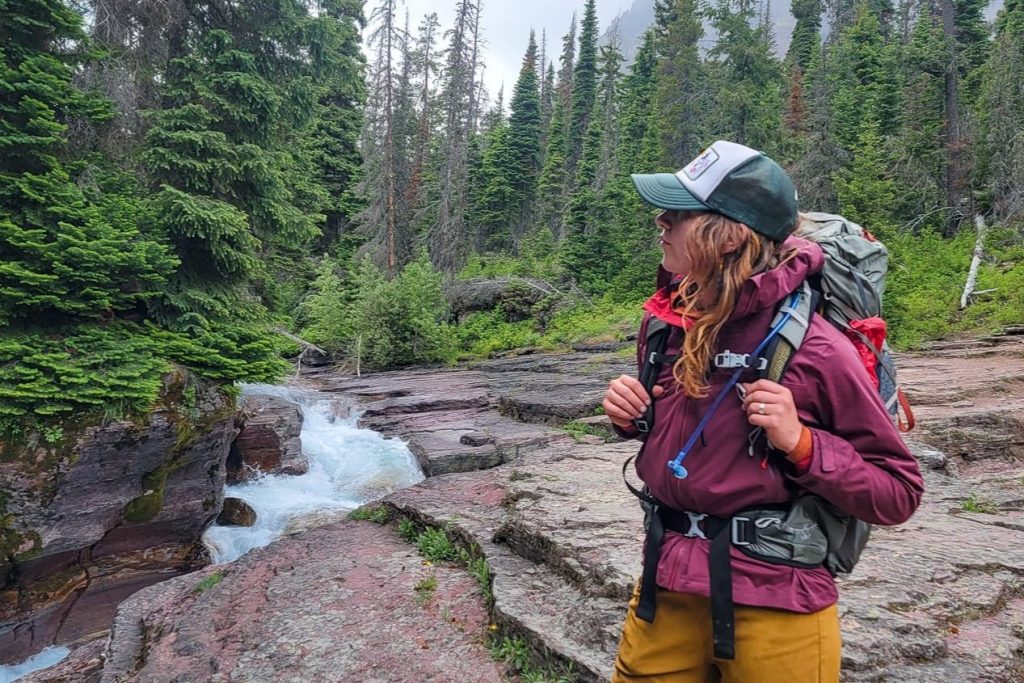
Product Comparison Table
| oSort | Product | Price | Weight |
|---|---|---|---|
| 0 |
Patagonia Torrentshell 3L View Men's View Women's |
$179 | 14.1 oz. (men’s) / 12.4 oz. (women’s) |
| 1 |
Outdoor Research Foray II / Aspire II View Men's View Women's |
$225 | 11.9 oz. (men’s) / 11.7 oz. (women’s) |
| 2 |
REI Rainier View Men's View Women's |
$100 | 11.3 oz. (men’s) / 9.9 oz. (women’s) |
| 3 |
Arc’teryx Beta View Men's View Women's |
$400 | 10.6 oz. (men’s) / 9.5 oz. (women’s) |
| 4 |
Mountain Hardwear Stretch Ozonic View Men's View Women's |
$230 | 10.7 oz. (men’s) / 9.9 oz. (women’s) |
| 5 |
Montbell Versalite View Men's View Women's |
$260 | 6.4 oz. (men’s) / 5.8 oz. (women’s) |
| 6 |
Zpacks Vertice View Men's View Women's |
$299 | 5.75 oz. (men’s) / 5.7 oz. (women’s) |
| 7 |
Black Diamond Stormline Stretch View Men's View Women's |
$180 | 11.3 oz. (men’s) / 9.5 oz. (women’s) |
| 8 |
REI Flash Stretch View Men's View Women's |
$169 | 17 oz. (men’s) / 14.5 oz. (women’s) |
| 9 |
Outdoor Research Helium View Men's View Women's |
$170 (men’s) / $180 (women’s) | 6.2 oz. (men’s) / 6.3 oz. (women’s) |
| 10 |
Marmot Precip Eco View Men's View Women's |
$120 | 11 oz. (men’s) / 9 oz. (women’s) |
What’s Most Important to You in a Rain Jacket?
PRICE
If you spend a lot of time outdoors in wet conditions, paying a bit more for a rain jacket with an accurate, cozy fit and high-quality materials is well worth the cost. That said, there are many wallet-friendly jackets that will keep you dry and comfortable in most wet conditions. Below, we recommend rain jackets at a variety of price points to suit every budget.
Best value rain jackets
Best budget rain jackets
COMFORT
You don’t have to settle for an uncomfortable, restrictive, or plastic-feeling rain jacket. There are so many great options that are designed with fit, movement, layering, and next-to-skin comfort in mind. We highly recommend trying on as many rain jackets as you’re able to to find the right balance of comfort and functionality for you.
WEIGHT & PACKABILITY
When you’re hiking, it’s a good idea to carry a rain jacket even if the weather looks clear, especially when venturing into remote areas. In fair-weather conditions, an ultralight jacket that hardly takes up any room in your pack is all you need to provide emergency, “just-enough” protection. If the forecast calls for sustained rain or afternoon storms, and you’ll likely be wearing your jacket for much of the trip, a light- to mid-weight jacket can be worth the extra bulk and weight for peace of mind.
Best ultralight rain jackets
DURABILITY
If low bulk and keeping your overall pack weight to minimum is your number one priority, ultralight rain jackets are the way to go. However, they tend to be more delicate than heavier options. Though durability, comfort, and bomb-proof weather protection come with a bigger weight penalty, a heavier-duty jacket may be more important when it comes to everyday wear or when you’re headed into particularly rugged backcountry terrain.
BREATHABILITY
Many rain jackets advertise that they’ve got the latest most “breathable” vapor barrier on the market, but the truth is, you’ll get hot and sweaty if you do vigorous exercise in any of them. That’s why we choose rain jackets with features that allow for excellent ventilation, like large pit zips and hem drawcords when we want a surefire way to release moisture and heat while staying cool on trail.
Best rain jackets with pit zips
- Patagonia Torrentshell 3L Men’s / Women’s
- Outdoor Research Foray II – Men’s / Aspire II – Women’s
- Montbell Versalite Men’s / Women’s
- Mountain Hardwear Stretch OzonicWomen’s
- Black Diamond StormLine Stretch Men’s / Women’s
- ZPacks Vertice Men’s / Women’s
- REI Rainier Men’s / Women’s
- Marmot Precip Eco Men’s / Women’s
- Arc’teryx Beta Men’s / Women’s
- REI Flash Stretch Men’s / Women’s
Critical Rain Jacket Considerations
NUMBER OF LAYERS
The number of layers in a rain jacket correlates to price and long-term efficacy. Here is what you can expect with each layer:
2-layer jackets are the most common and affordable. They’re typically constructed with an outer shell coated in a Durable Water Repellent (DWR) combined with a breathable liner.
2.5-layer jackets are usually the lightest rain jackets and are made with the same DWR-coated outer as 2-layer options. The inner layer of a 2.5-layer jacket is typically a thin polyurethane coating that helps keep sweat and dirt from clogging the breathable pores of the jacket from the inside.
3-layer jackets are the most effective in heavy moisture and they incorporate all of these elements: they have a DWR-coated outer shell, a breathable and waterproof mid-layer, and a polyurethane lining for the innermost layer. They also tend to be the heaviest.
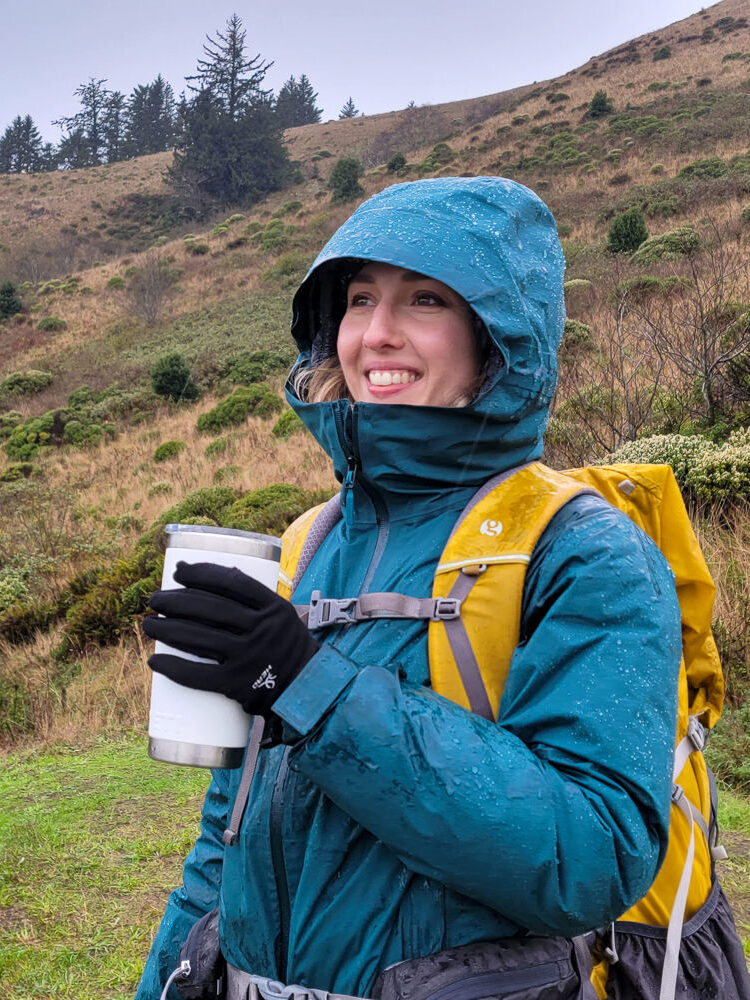
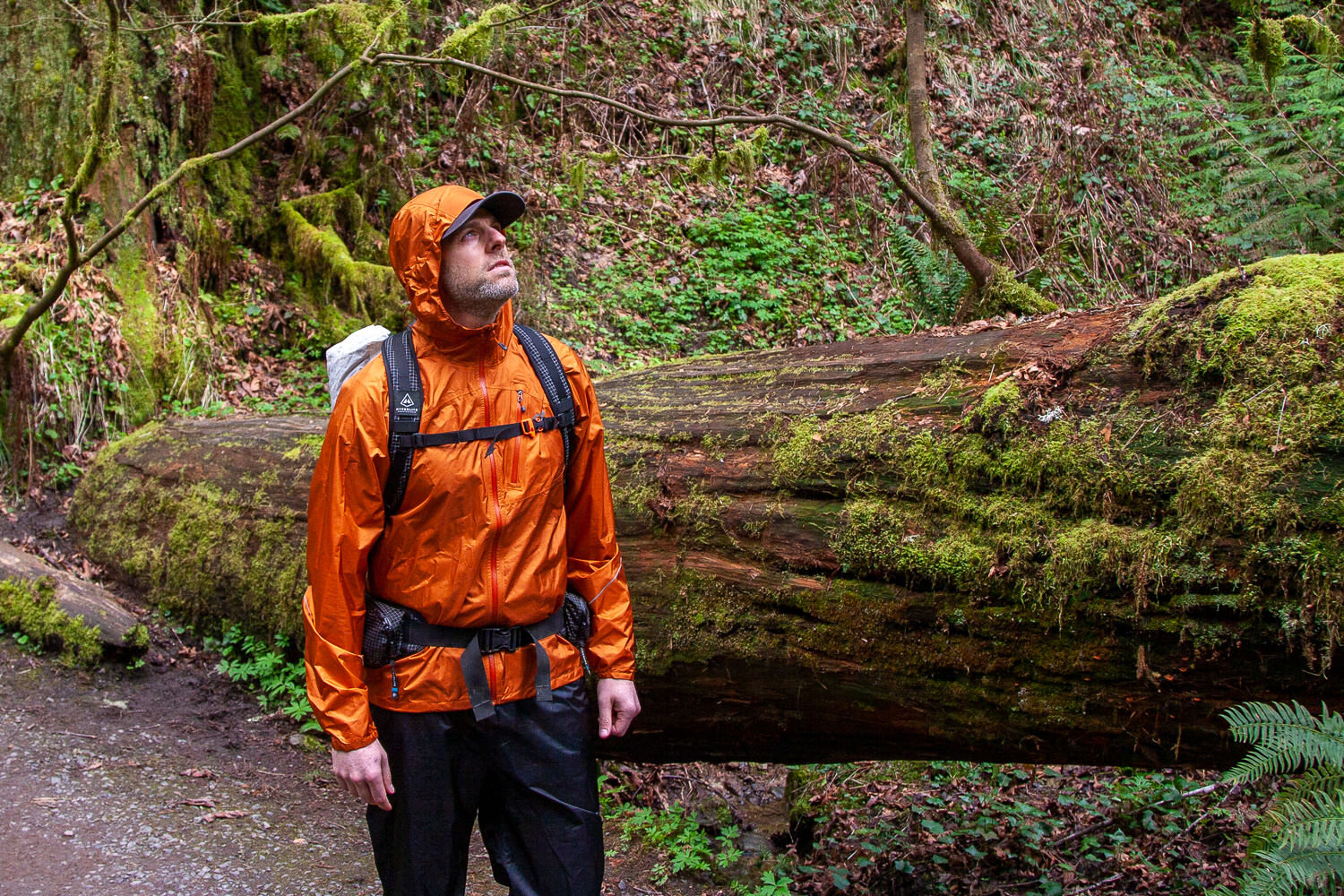
PIT ZIPS
Zippered openings at the armpits, aka pit zips, are great for letting excess heat escape if you get too warm while hiking uphill or being active. It’s always nice to have the option for more airflow when you’re sweating through a tough ascent in a deluge or feeling a bit too warm during a misty afternoon on trail.
CONDENSATION
If you’re wearing a rain jacket on a cold, rainy day, condensation will almost certainly form on the inside fabric. This leads many people to think that their rain gear is failing, even though it’s still waterproof and very much doing its job. If your jacket is new or has been well-maintained over its life, don’t worry too much if you feel wetness forming inside your jacket. The chances are very high it’s just trapped condensation, and it will evaporate with your body heat as long as you’re wearing appropriate wicking layers underneath and you maximize the ventilation.
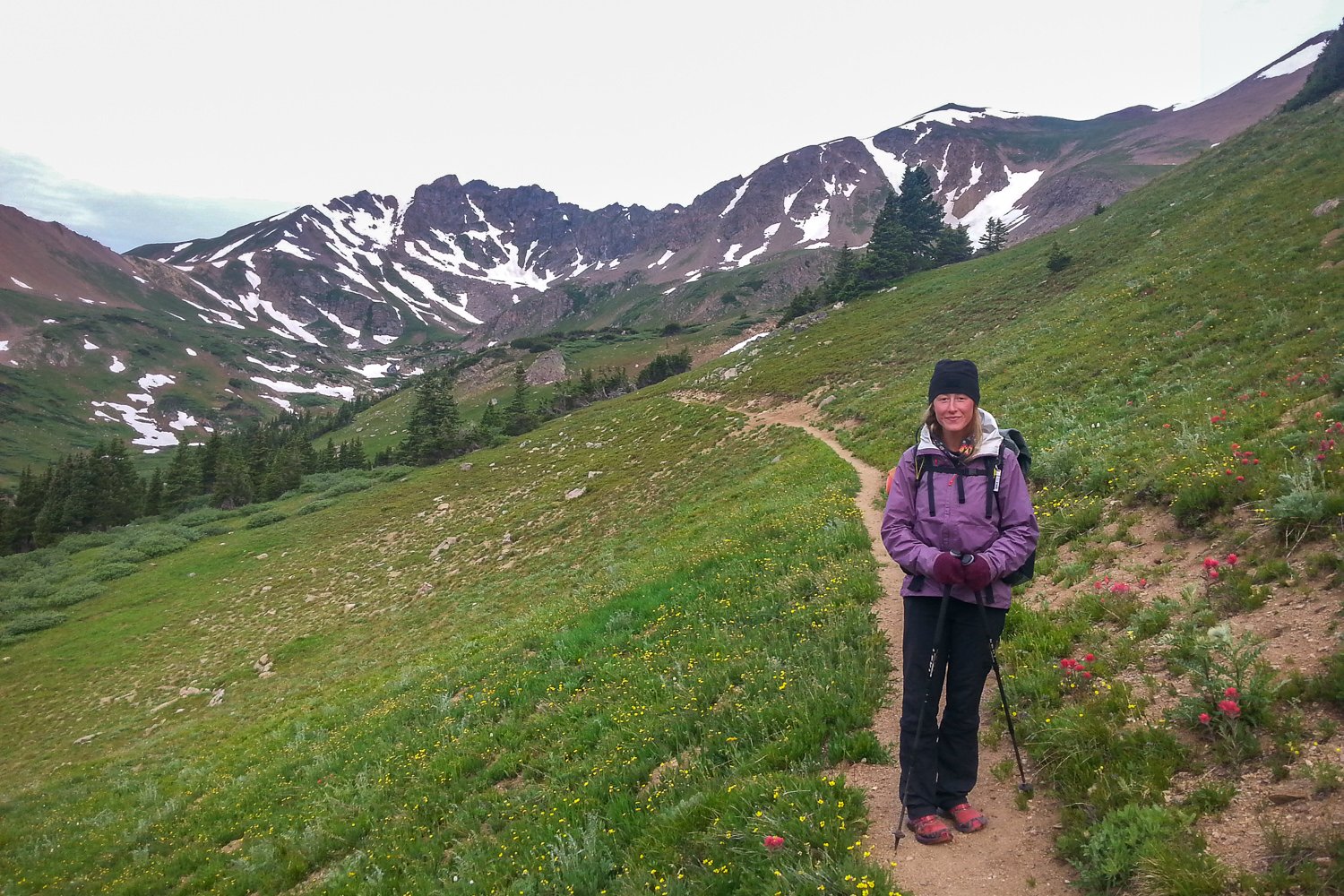
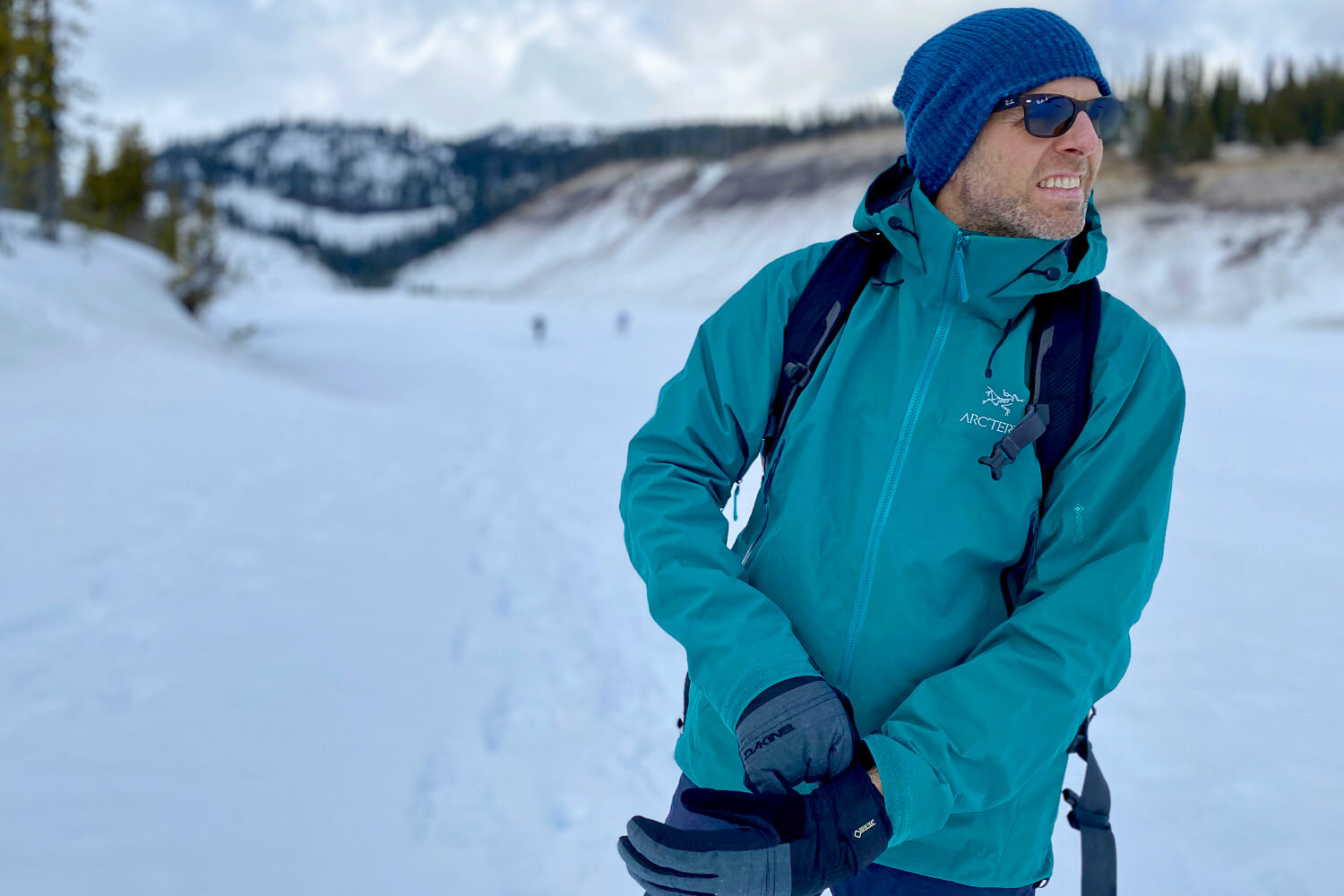
How To Stay Cool & Dry In A Rain Jacket
Getting hot and sweating when you’re working hard in a rain jacket is inevitable, and condensation build-up in chilly conditions is very normal and to be expected. Here are our top tips for staying cool and dry in your new rain jacket:
- Start cold – We recommend a single base layer under your rain jacket, especially if you hike quickly, or will be heading uphill right out of the gate. Using your go-to lightweight wool / synthetic t-shirt or base layer top under your rain jacket will feel cold at first, but you’ll find that it takes just a few minutes of movement before you start to warm up.
- Ventilate – You can quickly and easily dump heat through the pit zips, bottom hem, wrist cuffs, and front zipper. Finding the right amount of breathability is key, so consider taking a bit of time while hiking to make the micro-adjustments that will keep you cool and comfortable.
- Slow down – Moderating your pace will slow your heart rate and reduce sweating. If you find yourself a bit too warm or your jacket beginning to “wet out”, consider slowing your steps.
- Drink water – Drinking cold water regularly will cool you from the inside out. Just because it’s raining doesn’t mean you don’t need to hydrate, so be sure to drink up while you trudge through that tempest.
- Shed layers – When you’re hiking, temperature regulation is simply a layering game. If you find yourself overheating – or getting too cold – consider taking off or putting on a hat and gloves or a wicking mid-layer.
- Use rain pants – No waterproof clothing system is truly complete without quality rain pants. Check out our guide to the Best Rain Pants for our favorites.
- Waterproof footwear – For wet days and soggy hiking adventures, you’ll want to be waterproof from head to toe. Consider picking up a pair of waterproof hiking boots (Men’s / Women’s), hiking shoes (Men’s / Women’s), or rain boots (Men’s / Women’s) to keep your feet dry.
- Umbrella – Consider using a hiking umbrella not as a replacement for a jacket, but in addition. This is a great way to mitigate how wet your outer layers become, helps direct unrelenting rain away from you while moving, and offers unrivaled breathability on moist, warm, and hot days.
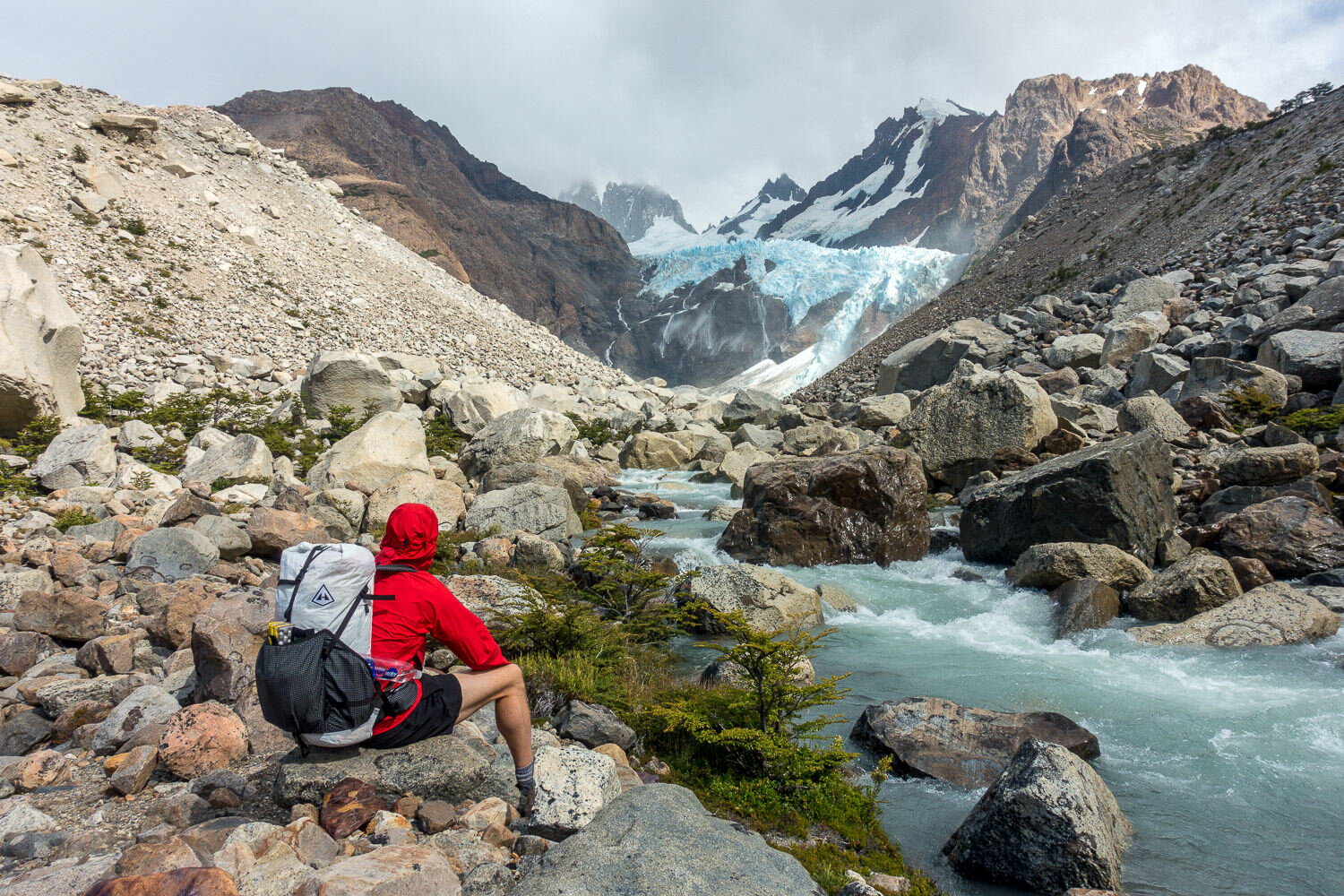
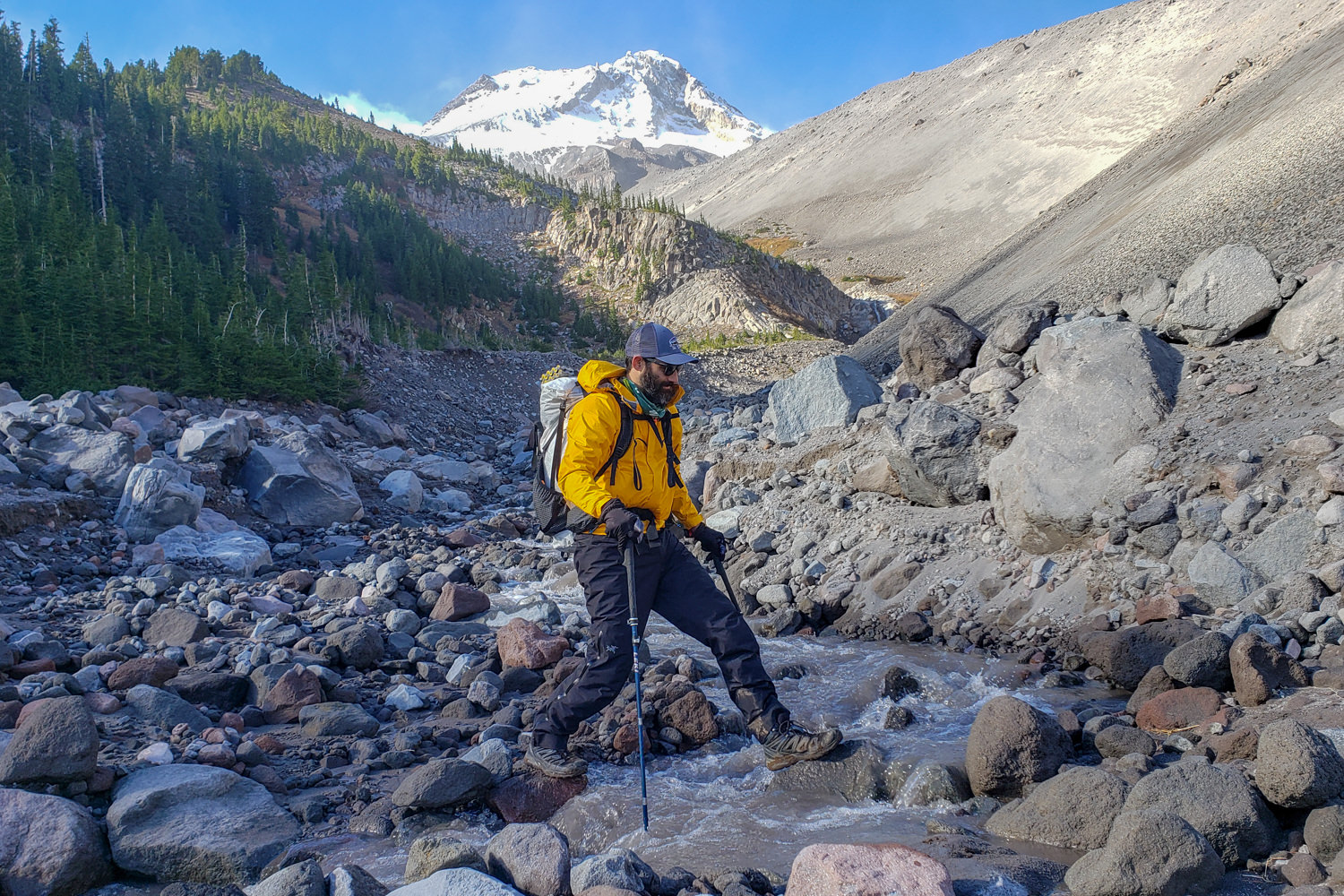
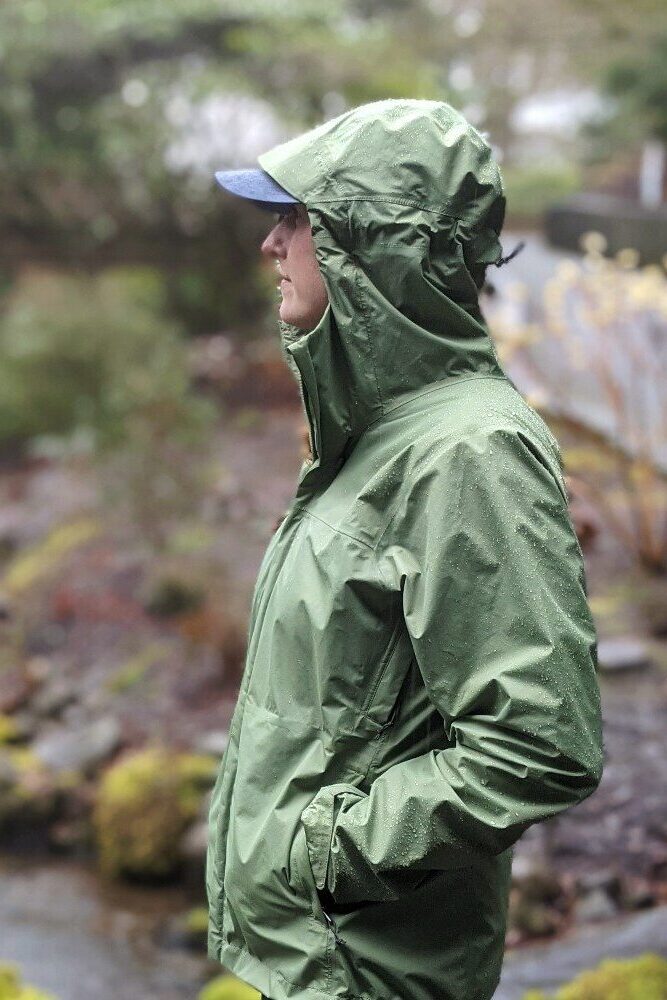
Honorable Mentions
You never know if this diamond in the rough might be perfect rain jacket for you:
Frogg Toggs Xtreme Lite (Men’s / Women’s)
The Frogg Toggs Xtreme Lite jacket is inexpensive and serviceable. As thru-hikers, backpackers, and peak baggers, our team of gearheads knows that sometimes the lightest, cheapest gear really is enough – and that’s the space where this jacket lives.
For only $60, the Xtreme Lite offers the core features we want in our top hiking rain jackets: handwarmer pockets, and adjustable wrists, hem, and hood. On top of that, this model packs into itself and weighs only 10 ounces. CleverHiker Gear Analyst, Casey Handley, carried Frogg Toggs as her outer shell for the northern 500 miles of the Arizona Trail. The Xtreme Lite functioned as a windbreaker in the cold wind, and a just-in-case layer for a rare desert downpour, and it was fine for both uses.
Though The Xtreme Lite is simply not as durable, breathable, waterproof, well-fitting, or feature-rich compared to the jackets above, it has its place. If you’re looking for an inexpensive jacket for mild conditions and arid places with occasional cloud bursts, Frogg Toggs are a solid option.
Best Ponchos
If your top priorities are full coverage and low weight, a poncho can be a great piece of gear. They are perfect when light or occasional rain is the norm. Though they can fall short when it comes to warmth and durability, a poncho might just be the right pick for you.
Outdoor Products Multipurpose Poncho
The Outdoor Products Multipurpose Poncho does everything we want a poncho to do. A simple drawstring hood cinches around your face, and a waterproof, seam-sealed, billowy body keeps your head and torso dry while offering plenty of breathability and freedom of movement for your arms. We like that the Multipurpose Poncho weighs nine ounces, folds down super small, and comes with a mesh zippered carrying case.
It’s fast to deploy and offers just enough coverage for your body when a downpour hits. Because this poncho is so lightweight, it also dries fast. For only $35, it’s a small and durable investment for the next time you’re caught in a brief rain shower or need a bit of extra coverage while setting up camp in the backcountry.
The Packa Poncho is a hybrid jacket, pack cover, and poncho. The Packa is a regular poncho – featuring a simple hood with the same extended material in front – but it adds a large, articulated back to also cover your backpack. For distance backpackers and thru-hikers dreaming of an all-in-one rain cover when rain storms hit, the Packa might just be what you’re after.
Several impressive, unique details solve many common poncho problems: massive sleeves slip on easily over other layers (and feature massive 20-inch pit zips to throw heat), and the hem and wrists have drawstrings to prevent billowing material. We’re especially smitten with the fact that you can put on the entire poncho in less than 30 seconds without taking off our packs.
Though it’s a bit heavy and bulky to store – between 13 and 18 ounces, depending on the fabric you choose, and it’s a bit pricey for a poncho, it is a unique and dynamic product, that’s worth every penny.
Six Moon Designs Gatewood Cape Poncho
For ultralight hikers who want the ultimate 2-in-1, the Six Moon Designs Gatewood Cape Poncho doubles as a shelter. This model is both a solid, reliable tarp that uses guy lines and a hiking pole for nights on the trail where protection is key, and a serviceable poncho for when summer rain storms start building and you’ve got miles to go.
However, combination gear always involves trade-offs. The Gatewood is made of a thin sil-nylon that’s prone to ripping and tearing, so you’ll need to be extra careful when wearing it near underbrush or places where it can snag. While we love the weight savings of the Gatewood Cape’s dual functionality, we learned the hard way that it is only a pro until you’re trying to set it up as a shelter while it’s raining. And, the Gatewood takes some practice to pitch, so you’ll want to have it down ahead of time.
We’ve seen the ultra-versatile Gatewood gaining traction out on the trails more and more over the last few years, and for good reason – when it comes to a rainproof option and lightweight shelter for a low price, the Gatewood Cape Poncho is tough to beat.
Best umbrellas
An umbrella is one of the most overlooked pieces of rain gear on the trail. Though it’s not a replacement for a quality rain jacket, it can be a real game changer when combined with one. Staying dry (and therefore warm) is essential to your well-being, and for a small weight penalty, you get incredible versatility from umbrellas like the ones below.
Though umbrellas fall short in high winds and lightning, they are a very worthwhile addition in both scorching desert heat and pouring rain.
Gossamer Gear Lightrek Umbrella
The Gossamer Gear Lightrek Umbrella is a robust ultralight umbrella with a shiny, sun-shielding exterior. CleverHiker Managing Editor, Ben Applebaum-Bauch, used the Lightrek on his thru-hike of the 3,000-mile Continental Divide Trail as a complement to his rain jacket and it was an absolute game-changer. It was a vital piece of gear not only for all-day protection from the sun but in the early season snow, heavy rain, and hail of the high Rockies.
We’re big fans of the Lightrek’s chromatic outer layer, which keeps intense UV rays and mid-day desert heat away from the user, and it can even help lower the temperature underneath. This umbrella also has pack attachment straps (sold separately) and stores narrow (but long) in your pack.
We’ve found the Lightrek excels in all conditions except for sustained high winds – but to be fair, it’s plenty durable for a 6.3-ounce umbrella. This thing will last for years if you take proper care of it, and we wouldn’t hesitate to recommend it for long adventures in rain or shine. For only $39, the Lightrek is a bargain.
Six Moon Designs Rain Walker Umbrella
At 5.5 ounces, the Rain Walker Umbrella is a low-bulk and efficient ultralight umbrella. If you’re looking for serious coverage at the lowest weight possible, the Rain Walker is a great choice: at full size, it easily covers one hiker and their backpack from the elements. CleverHiker Gear Analyst, Heather Eldridge, uses the Rain Walker for local hikes in Oregon.
Thanks to flexible, wind-resistant ribs, the closed umbrella packs up ultra-thin – barely the diameter of a quarter – and collapses down to about two feet. It’s easy to store, fast to deploy, and we love the soft EVA handle for holding over a long time. Plus, Six Moon also offers attachments for securing your umbrella to the shoulder strap of your backpack so you can hike hands-free.
The downside of the Rain Walker is it’s a bit less durable than other options on the market, and it doesn’t come with a reflective outer layer. If sun shade is a priority for your umbrella, we highly recommend the Silver Shadow or the Silver Shadow Carbon by Six Moon as well.
The ZPacks Lotus has a strong and balanced construction. It also offers the widest diameter of these three umbrellas at a whopping 38 inches, which provides a ton of shade and rain protection.
We really like the attachment method (sold separately) for the Lotus umbrella. Instead of two stretchy ties, one of the “holsters” is a low-bulk clip that attaches directly to the strap of your backpack. We find that this design offers more stability for the umbrella, and needs less tweaking and adjusting over time.
That said, the Lotus itself is the most flimsy in wind compared to the other umbrellas on this list. We find a sudden breeze can dramatically strain the ribs under the material. The handle is also small and less comfortable. However, the Lotus is an outstanding option for long-distance treks: its chromatic exterior will reflect the sun’s heat, it packs small and is under seven ounces.


